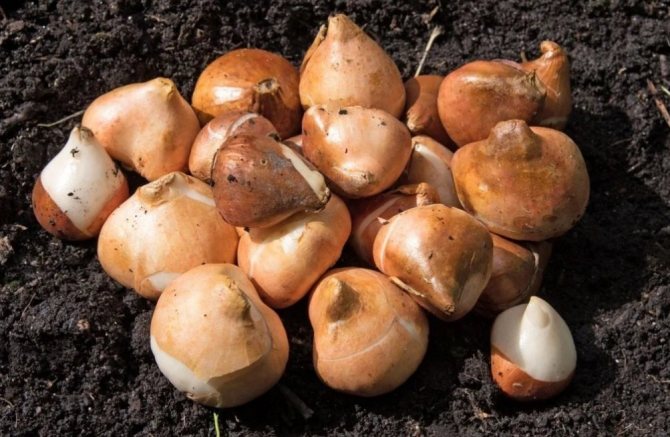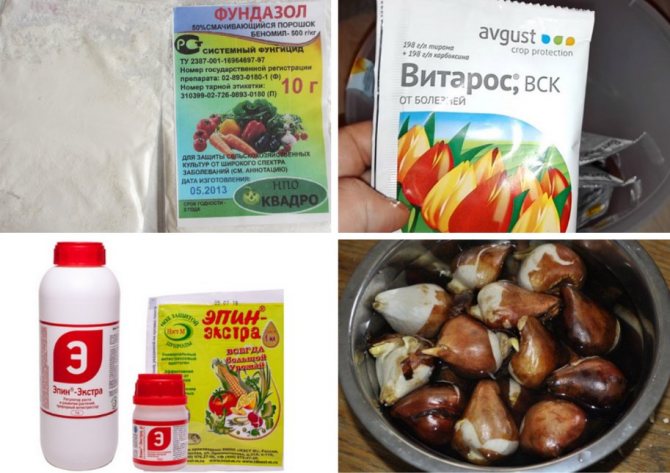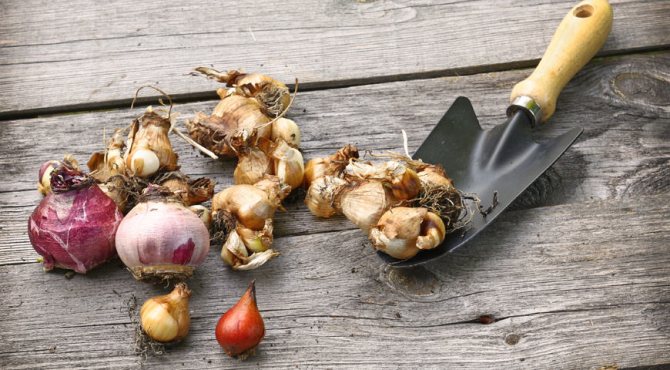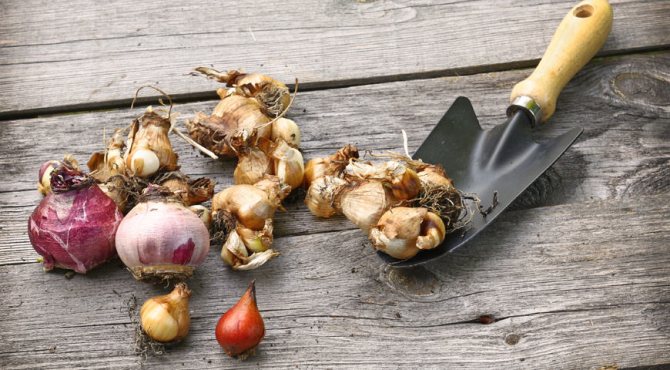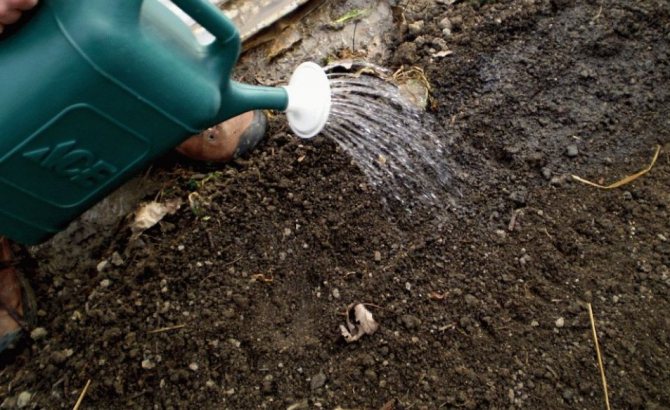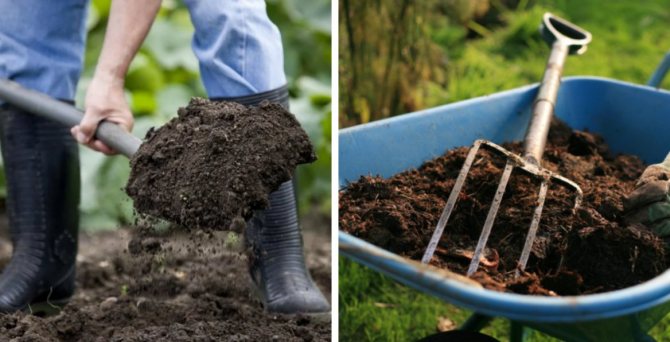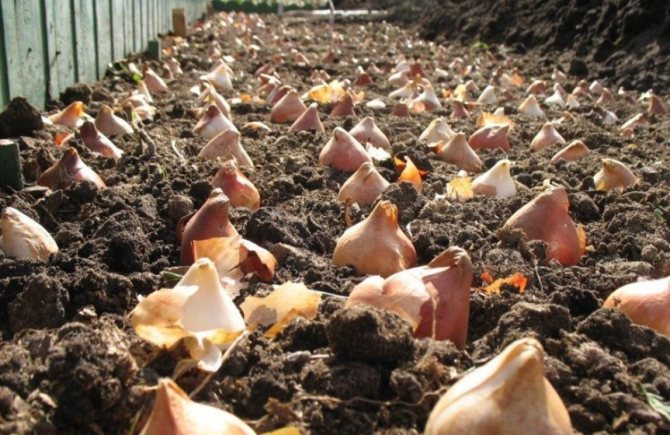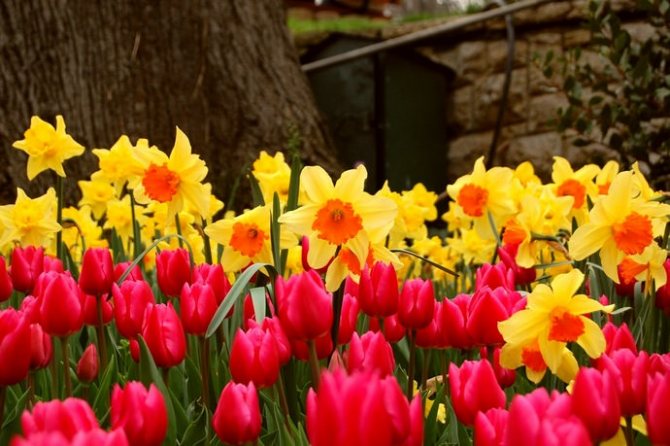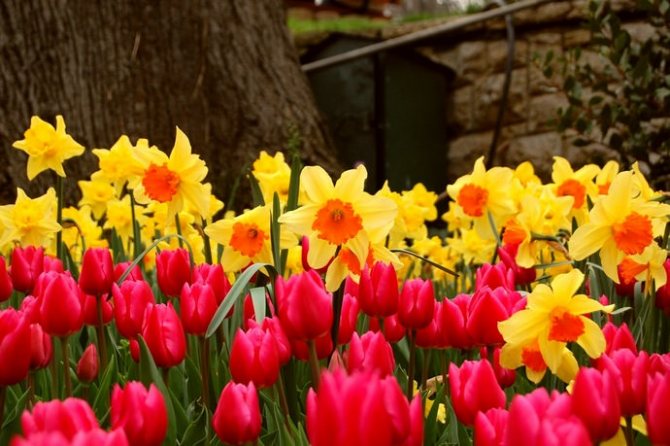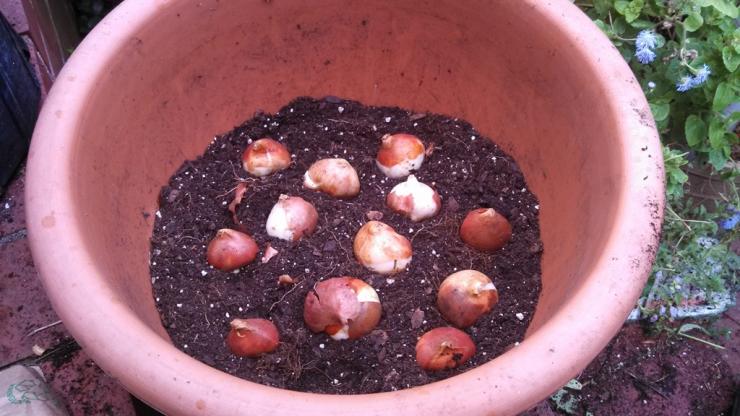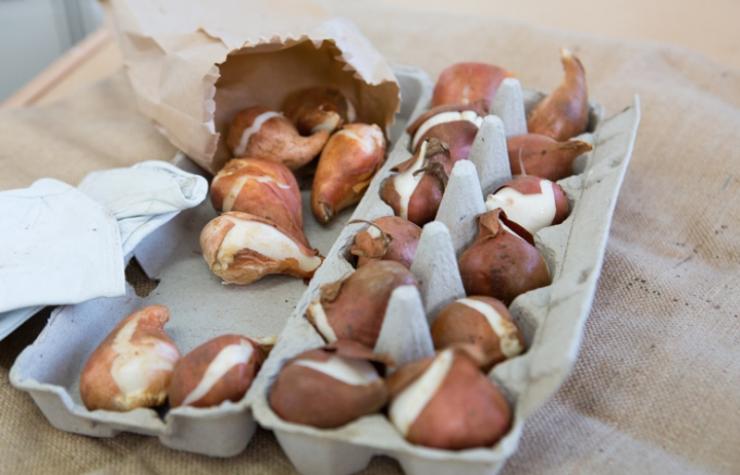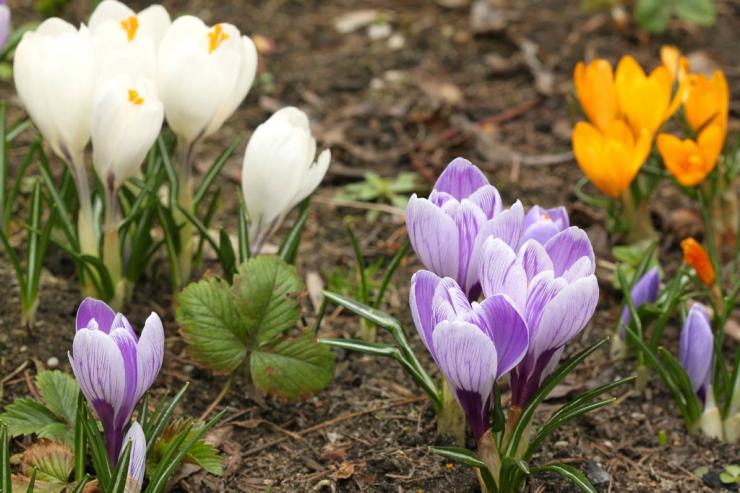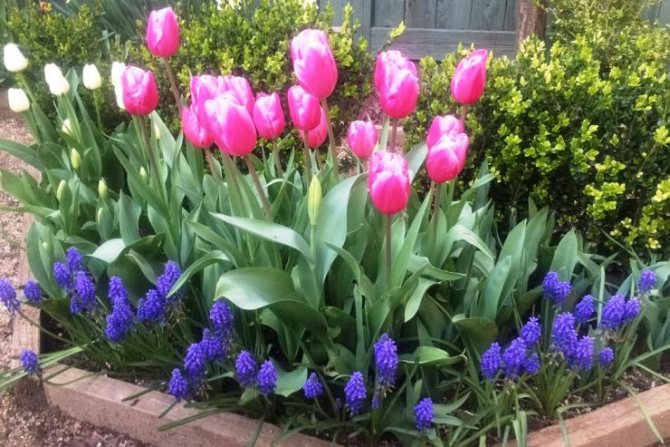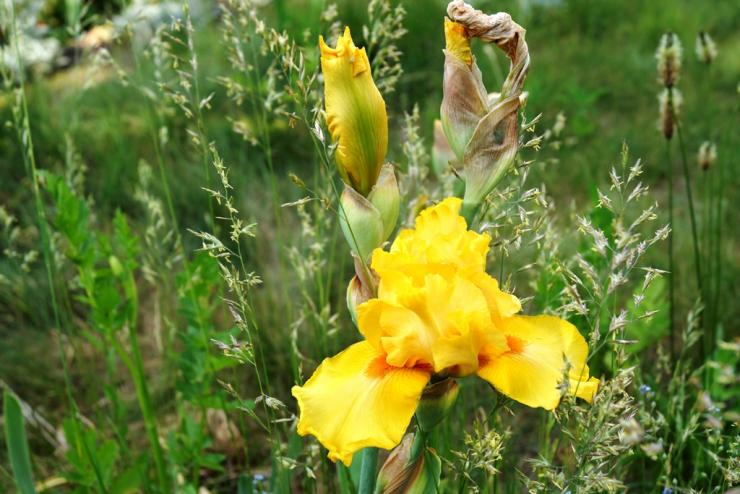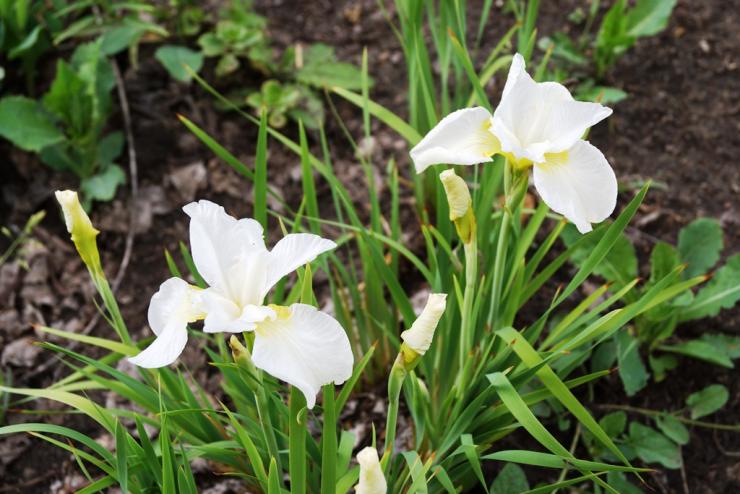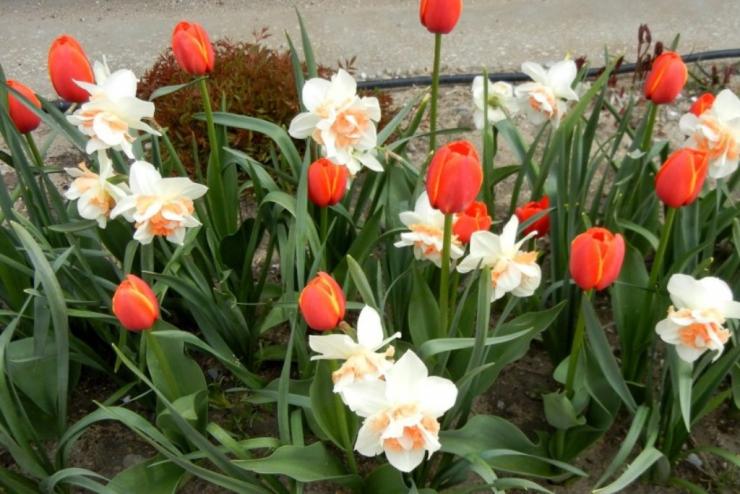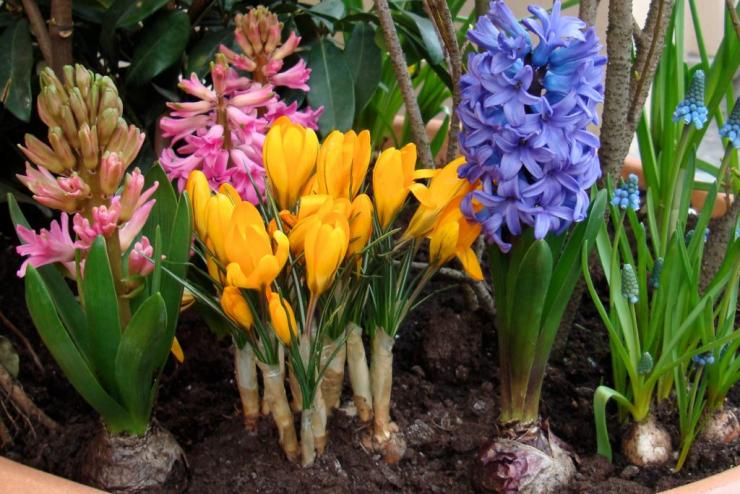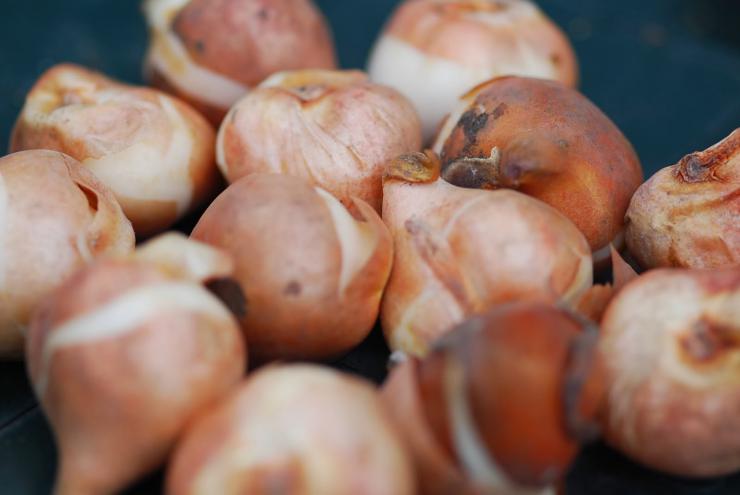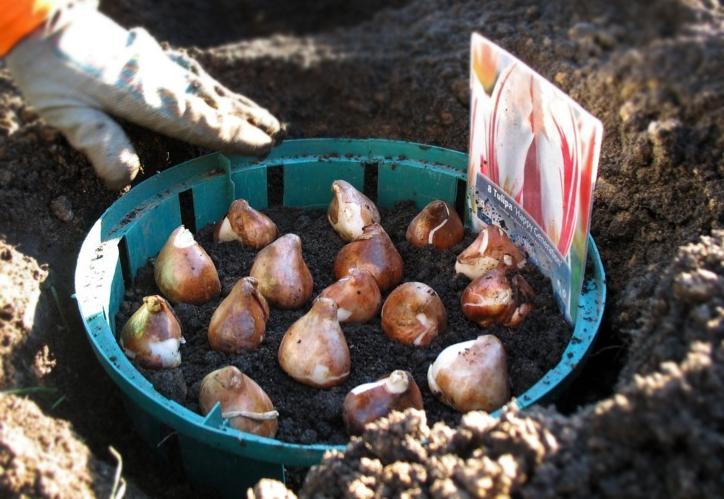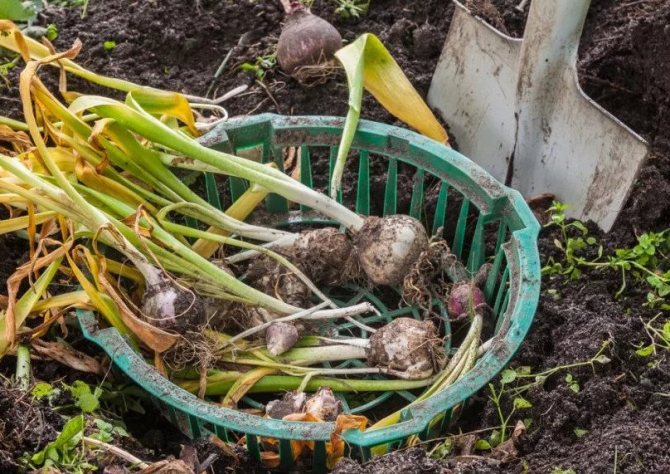Plants »Flowers
1
725
Article rating
Each gardener chooses the timing of planting for his flowers. But it is known that planting tulips in the fall in the Moscow region has a beneficial effect on flowering. Let's figure out how to plant tulips in open ground and greenhouses in central Russia and the environs of Moscow.
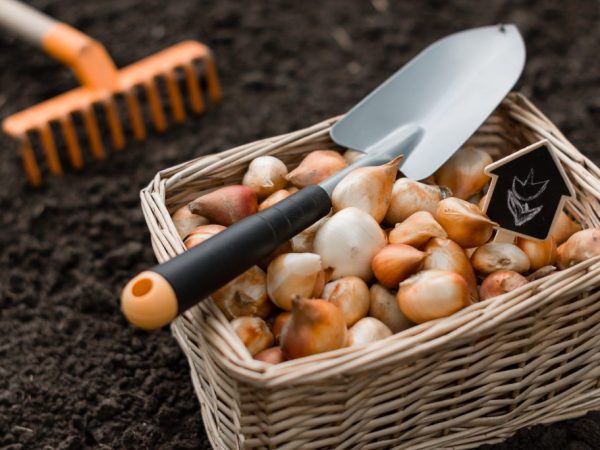
Rules for planting tulips in the fall in the Moscow region
When to plant
The optimal timing for each type of plant is different. If they are not adhered to, then the bulbs may start to grow when planted early, or not have time to take root and freeze out too late.
Daffodils should be planted from mid-August to early September. Their dormancy period is too short - these flowers need to be planted before the first roots form.
In August - September, lilies are planted, then crocuses. And from the middle of September - tulips. For them, it is desirable that the soil temperature at the planting depth drops to 10 ° C - at higher bulbs take root worse.
At the same time, decorative bows are also being planted. Onions adapt to a new place for about two weeks and, if there is no stable frost, it is not too late to plant it even in November.
After tulips, by the end of the first autumn month, it is time for hyacinths. Rooting is most successful when the soil temperature is between 6 and 8 ° C. If there is enough moisture in the soil, then the roots appear under such conditions after two and a half weeks.
In which month of autumn is it better to plant tulips in the suburbs
Planting tulip bulbs outdoors is best in the fall months. They do this so that in the spring, with the onset of the thaw, the plants will immediately please the eye with their flowering.
Autumn in the Moscow region is cold, since the end of September the air temperature in the daytime drops to + 5 ... + 10 ° С, which is most optimal for the rooting of flower bulbs. This weather in the region persists for a period until about October 20, so the time for disembarkation should be between September 20 and October 20. You should not plant the bulbs in the ground in the first decade of September, because the plant can quickly take root and start growing. Late disembarkation should also be avoided. After October 20 and November, tulips are not planted due to possible frost, which will harm the plant.
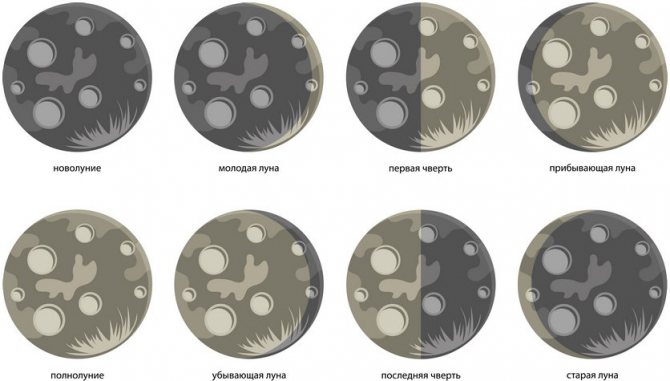

Where to plant
It happens that in the spring, gardeners find that the plants planted in autumn do not bloom, look pale and weakened, or even do not appear from under the snow at all. The most common reason is the wrong landing site.
The vast majority of bulbous plants develop best and bloom luxuriantly in sufficiently lighted areas. Only in the south, in order to extend the flowering period and keep the decorative effect longer, you have to choose a place protected from the hot rays of the midday sun.
Ground water in the area where bulbous plants grow should be at a depth of at least half a meter from the soil surface.
If planting is planned where vegetables were previously grown, then one should not forget that bulbous plants cannot be grown after tomatoes and melons.They will feel bad in the flowerbed that the asters occupied. Legumes, cabbage, potatoes, various roots and herbs are considered good predecessors for them.
Why is it better to plant bulbs in autumn than in spring
Many experienced domestic growers prefer autumn planting of bulbous plants, which due to a number of advantages:
- in the spring, gardeners and gardeners have to plant a significant amount of vegetables and other crops, so there is not always enough time for flowers;
- there is no need to store planting material throughout the entire winter period, which is especially important if you need to store a large number of bulbs;
- when planting in spring, it is extremely rare to get a high-quality and long-lasting flowering in the same year.
How to plant
Despite the variety of bulbs that prefer autumn planting, there are rules that are common to all plants in this group:
On light soil, the bulb is immersed in the ground to a depth equal to three bulbs; - if the soil is heavy, the bulb is immersed in the ground no deeper than two of its heights; - for an autumn planting, it is advisable to make a so-called "sand pillow", when washed river sand is placed on the bottom of the hole or landing groove, with a layer of at least 3 cm; - you can make a whole "shirt" out of sand by putting this material that drains water well on all sides of the bulb and only then cover it with earth - this technique not only improves drainage, but also helps in the fight against soil infections; - immediately after planting, the onion should be watered; - to ensure wintering, the planted bulbs are recommended to be mulched with loose organic material - peat, rotten sawdust or simply dry leaves; - before planting, it is advisable to disinfect the bulbs by keeping them in a half-percent solution of potassium permanganate for about an hour.
Tulip care
Despite the fact that tulips are unpretentious flowers, improper care of them can lead to rotting of bulbs or wilting of foliage. That is why it is necessary to observe the frequency of watering and fertilize on time.
Care rules after germination of flowers:
- After the sprouts appear, the plant is carefully examined for dryness, wilting and darkening of the leaves. If there are any, they are dug up and destroyed.
- The soil near the sprouted bulbs is loosened in order to eliminate the problems of moisture stagnation and to enrich the rhizome with oxygen.
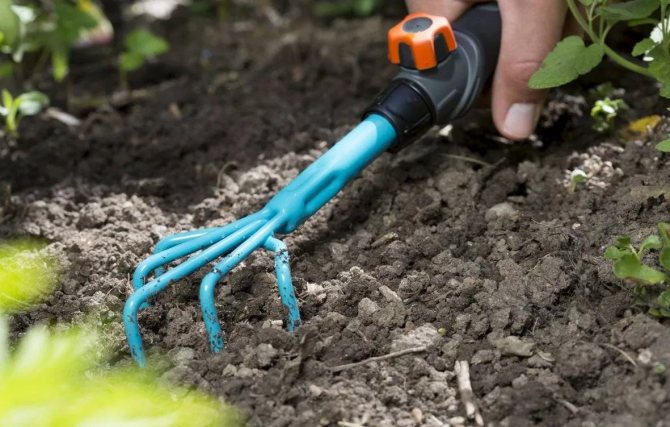

Proper watering
For plants to be healthy and beautiful, they need to be watered regularly. Drying of the soil and stagnation of moisture should not be allowed, therefore, the introduction of water under each flower should be moderate. For one plant, 200-500 ml of water is enough. It should be kept for 2 days and at room temperature, approximately + 18 ... + 20 ° С. After each watering and rain, it is imperative to weed the earth. This procedure will avoid crust formation on the soil surface and will enrich the roots with oxygen.
Learn more about how to care for tulips after flowering.
Top dressing and fertilization
During the period of intensive growth and budding, you can make 2 dressing of tulips.
Fertilization sequence:
- After the emergence of sprouts, fertilizing with nitroammophos is carried out (30 g per 10 l of water). The solution is used for 1 m² of the area.
- During the budding period, potash and phosphorus fertilizers are applied. To do this, you can use potassium monophosphate, 10 g of which is diluted in 10 liters of water. This solution is used for 1 m² of area.
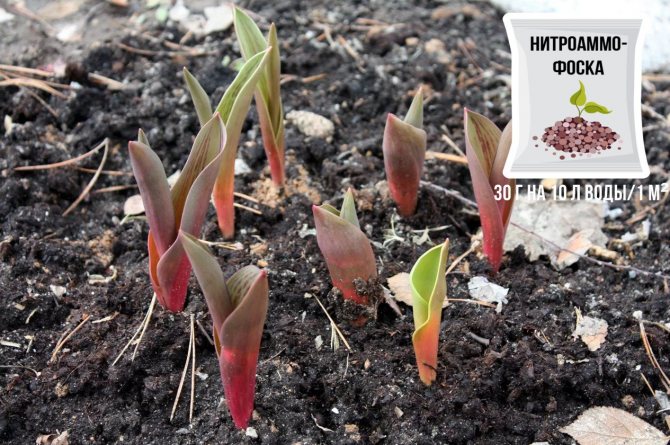

How to prepare the soil
The soil for the autumn planting of bulbs should be dug to the depth of a shovel bayonet. All weeds must be carefully selected. It is imperative to break large clods of earth, and level the surface of the future flower bed or garden.Even small depressions can lead to stagnation of water, which will lead to rotting and disease of the bulbs due to soaking.
Ideally, a flower bed or garden bed for autumn planting begins to be made at least two weeks in advance. But if the land is being prepared just before landing, it is better to let it settle and compact for at least a couple of days.
Why process onions before planting in the fall
Before boarding take healthy seed... It must be clean and free of damage, up to 3 cm in diameter.
Important! Dry or sprouted bulbs are not suitable for planting.
Before the start of planting in the fall, fertilize under the onion, the selected bulbs are processed. This is done to prevent diseases and obtain a high-quality harvest.
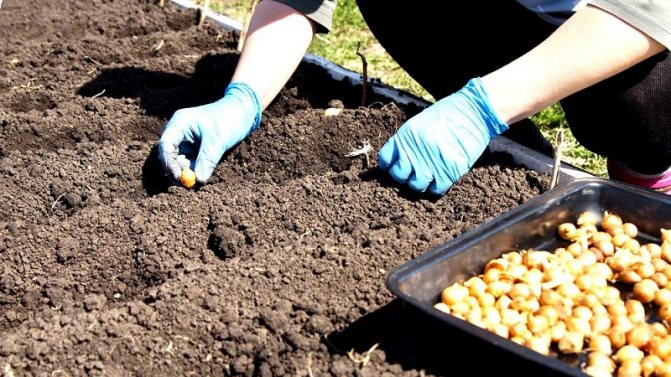

Benefits
There are various ways to process onions.
All of them are aimed at:
- protection from pests and diseases;
- decrease in the formation of flower arrows;
- improving the quality of the crop;
- an increase in the size of the crop;
- increased germination.
What to feed
Clay, humus and well-ventilated peat are pre-added to the sandy soil. In clay - sand and leafy soil. The simplest recipe, calculated per square meter of planting:
Humus - 5 kg; - superphosphate - 50 g; - potassium sulfate - 30 g; - bone meal - 200 g.
If necessary, potassium sulfate can be replaced with the same amount of potassium nitrate, and bone meal - with a glass of sifted wood ash. Ash should be exactly woody - coal slag and the remains of burnt peat briquettes are not suitable. Nitrogen fertilizers are applied directly at the time of planting the bulbs - about 25 g.
In no case should fresh manure be introduced. Organic acids, like pathogenic bacteria, contained in large quantities, can significantly weaken the bulbs and increase their susceptibility to fungal diseases. Fresh organics can even simply burn the thin surface flakes. As an organic fertilizer, it is permissible to use only humus or well-rotted compost that has lain for more than one season.
When to plant tulips in the fall in open ground and how to properly
Tulips are vivid representatives of early spring flowers. They look spectacular when planting in groups in flower beds and beds. Flower bulbs are allowed to be planted both in autumn and spring. But not many people know that autumn planting is more preferable for plants. Having figured out the timing and technology of planting tulips, next spring flowers will delight you with beautiful and bright flowers.
Autumn is a great time to plant tulips.
Tulips, in order for them to quickly germinate and grow in spring, require a cooling period. In the fall, when nature prepares for a dormant period, the planted tulips are activated. Growth processes begin in them, roots are formed, which store food for the development of the upper part of the flowers next spring.
Planted tulips in spring, bloom much later than planted ones, before winter. The stems of the flowers are thinner, and the flowering is weak. Plants during spring planting do not have time to fully develop due to the lack of a cooling period, which negatively affects their appearance, as well as the quality of the bulbs that will be collected for the next planting.
Even experienced gardeners from time to time make mistakes in determining the period for planting tulips. Having planted the bulbs later than the term, tulips do not have time to take root until the first frost and in spring their development and flowering is greatly delayed.
When planting too early, the plants sprout, freeze at the first frost and ignite, sometimes they sprout in the spring, but they bloom late and poorly. In addition, such plantings are overgrown with weeds, which interfere with the growth and development of flowers in spring.
Tulips must be planted on time and each region has its own.
In the middle lane
In the climatic conditions of Central Russia, tulips are planted from the last decade of September to mid-October.
When choosing a day, you need to focus on the air temperature at night, when the air temperature drops to 3 degrees Celsius and will stay at such indicators for 3 days.
In outskirts of Moscow
Dates for planting tulips for the Moscow region are at the end of September - mid-October. Snow in this region falls in November, by which time the bulbs have time to take root, but do not grow.
In the Urals, in Siberia
The planting of tulips in the Urals is divided into its own regions.
- In the Middle Urals, tulips are planted from the end of August to the end of the second decade of September.
- In the South Urals, planting lasts from early September to the beginning of the second decade of October.
- In the Northern Urals, planting ends in mid-September.
In Siberia, the first frost can come quite early. To prevent the bulbs from freezing, it is better to plant them in the last days of August. If the weather permits, these terms can be shifted until mid-September.
The healthy, largest bulbs are selected before tulips are planted. Small, damaged and sick ones are not used for planting.
Before planting tulips in the ground, the bulbs are placed in the refrigerator overnight. In the morning, they are treated with a 0.2% solution of karbofos, and then for half an hour they are placed in a pink solution of potassium permanganate or any antifungal agent, for example, Agate, Maxim, Albit, Oksikhom, Skor or Hom.
Read more: Description of the cherry variety Iput with a photo: height, pollinator for a tree, planting and care with video
Seat selection
For planting tulips, a well-lit, wind-protected, level, slightly elevated or slightly sloping place is chosen. The site should not be shaded by buildings, a fence, trees. The shade negatively affects the quality of tulips flowering.
The main requirement for planting is good drainage. With a close passage of groundwater, the roots begin to rot, which leads to damage to the bulbs and the death of flowers. Groundwater should pass at a level of 1.5-2 meters from the surface of the earth. With a high level of groundwater (on sandy loam - up to 100 centimeters, clay soil - up to 40 centimeters), it is necessary to build a drainage system.
Land preparation
The soil should be fertile, loose and slightly acidic. It should be good for both air and moisture. The site is cleared of weeds.
The structure of heavy clay soil during digging is improved by the introduction of river sand and peat (5 kilograms per square meter). Clay crumb is applied to the sandy area (bucket per square meter).
In any soil 2-4 weeks before planting, 5 kilograms of compost or rotted humus, 0.2 kilograms of wood ash, 15 grams of ammonium nitrate and 50 grams of superphosphate are introduced for digging per square meter.
In dry weather, 2 days before planting the bulbs, the soil is spilled with water and leveled with a rake. In loose and moist soil, it will be easier for the roots to grow.
Immediately before planting, the flower bed is spilled with a warm solution of potassium permanganate or fungicide to destroy harmful microorganisms in the soil.
Tulips are planted in holes or in rows. The bulbs are placed with their bottoms down. You cannot press on them when landing! The depth of the holes should be 3 times the height of the bulbs.
Planting depth for extra-class bulbs is 15-18 centimeters. Tulip bulbs 2 and 3 parsing are planted to a depth of 10-12 centimeters, children - 6-8 centimeters. On light soil, the bulbs are planted deeper, and on heavy soil, on the contrary, shallower.
The distance between the tulips should be 6-10 centimeters (depending on the size of the bulbs). The row spacing should be 25 centimeters.
Larger bulbs are placed in the center of the flower bed, and small ones on the sides, then taller plants will not block the light with low ones and the flowers will bloom evenly.
When planting bulbs of various varieties, the flowering time of the groups is taken into account, this simplifies further care.
The bulbs are dusted with wood ash and sprinkled with sand on all sides. After that, the decomposed bulbs are covered with loose earth.
If you need to lay out some pattern with tulips on the flower bed, then the top layer of soil is removed from the site. The bulbs, on a leveled surface, are placed according to the pattern, after which they are covered with pre-cut and crushed soil.
To achieve a carpet effect, the bulbs are planted in a checkerboard pattern. About 100 tulips are consumed per square meter of a flower bed.
The planting of flowers is done carefully so that the roots of the plants are not damaged. After planting the bulbs, the beds are leveled so that water does not accumulate on them. If necessary, a drainage system is formed around the flower bed to drain water.
Planting care
After planting tulips, no need to water the bulbs. If there has been no rain for 10 days, the flower bed is moistened from the watering can.
When watering plants, you can feed them a little with ammonium nitrate (15 grams per square meter of the flower bed).
In warm weather, it is not necessary to cover the planted tulips with mulch, since excess heat will provoke premature growth of the bulbs and the sprouts will die in case of frost.
Rodent protection
The heads of bulbous plants planted in the fall are a favorite treat of field mice, rats and other uninvited inhabitants of our gardens. Getting to tasty, they are able to gnaw through even the plastic nets of special protective baskets. Salvation can be a box made of wire mesh, which is not difficult to make on your own.
Bulbous flowers stand out among all the others. They are planted before winter, so that in the spring, when the snow melts and the earth begins to warm up, these amazing creatures begin to delight gardeners with their colors and delicate aroma before anyone else. Their distinctive feature is smooth, juicy and tender to the touch stems, which are not at all similar to the stems of later relatives in the flora kingdom. Consider what bulbous flowers can be planted in September-October and how to plant them correctly in order to get the result in spring.
Choosing a place for a flower bed
It is better to grow tulips in well-lit, wind-protected areas. For this, flower beds near houses or outbuildings are perfect. Planting is carried out on black earth, sandy loam, loose soils. The acidity of the soil should be neutral.
Important! When choosing a location, it is best to opt for elevated areas that will not be flooded when the snow melts or after a heavy downpour, otherwise the rhizome of the plant will rot.
Small and large brothers
Let's start with small-bulbous flowers, which include snowdrops, scilla, crocuses and muscari. The time of their planting is at the beginning of September, but in the southern regions this time is delayed until October. These plants are not large in size, therefore the greatest aesthetic effect is achieved with the mass planting of flowers. But one by one, any of these species will delight no less.
Much larger than the bulbs of lilies, tulips and daffodils, which are planted later than snowdrops and scillas - at the end of September and until the end of October.
The main condition for planting any bulbous flowers is to have time to plant them at such a time so that the bulb can take root in the ground and acquire a good root system, but at the same time it does not germinate before the first frosts come.
You don't have to dig up the fall flower bulbs after they have faded. They will definitely bloom again next year. You just need to take into account that varietal traits will be lost every year, so that the renewal of flowers will be necessary.
Storing tulips before planting
After flowering, the tulip bulbs are dug up and prepared for storage. To do this, perform the following functions:
- cleaned from the earth;
- dipped in a weak solution of potassium permanganate for half an hour;
- dried in the shade;
- a week later, the planting material is examined, calibrated, the children and sprouts are separated and dried for some time.
In summer, planting material is stored at a temperature of 20 degrees. Humidity is retained at 70%. In winter, the storage temperature is lowered to 17 degrees - this is in the case of spring planting.
Tulips are folded in boxes and sprinkled with sawdust or wrapped in paper.
The storage place can be a ventilated basement, an insulated balcony, a refrigerator (compartment for vegetables), a heat chamber.


Bulb planting rules (video)
Before planting the bulbs in the ground, take a close look at their condition.
The bulbs must be flat and free from disease and rot.
If any are found, get rid of such bulbs without pity. It is better to lose one or two bulbs than to regret them and re-inoculate all the flowers in the garden. But if there are traces of damage on the bulbs, dip them in a solution of potassium permanganate to carry out disinfection. Damaged places can be treated with brilliant green for a heightened effect.
Prepare a planting site. The top layer of soil must be removed, and fine sand must be sprinkled on the bottom. It is advisable to place the bulbs at a distance of 10-15 cm from each other (usually for large bulbs). Each bulb is pressed to the ground and covered with soil.
If the soil on the site is clay, the best option is to mix the backfill soil with humus or peat.
In addition to good watering of the planting site, mulching must be carried out. Do not forget to mark this place with pegs so that you do not accidentally disturb the bulbs during the spring digging.
The situation is much simpler on loose fertile soil. There is absolutely no need to do drainage, it is enough just to make a deepening in the ground, plant the bulbs at a certain distance from each other and cover them with water.
Is it possible to buy bulbs late - at the end of autumn - and how to plant them?
Bulbs of daffodils and tulips are often sold at autumn sales - of course, you can buy them. Firms often make good discounts on this raw material, since it is considered overdue for them. But in fact, there is nothing critical about this. Such bulbs can be safely planted then, even if the soil is already slightly frozen. They will bloom no worse than the rest. The only condition that must be taken into account when planting such bulbs is that they will definitely need to be covered for the winter. Bulbous shelter should be dry and well ventilated.
To plant medium-sized bulbs in cold soil, you first need to place them in a pot with garden soil, use a drill or scrap in the frozen soil to make a sufficient deepening, put the pot, bury with removed soil, mulch the planting site with peat and cover it with covering material (spunbond, lutrasil ).
If during late planting the bulbs (corms) were covered from above with spruce branches (film, non-woven material, foliage, etc.) or a large layer of compost, then in the spring, before flowering, the mulching layer must be raked off, and the covering materials must be removed.
Grouse and fritillaria
Another representatives of liliaceae are not so often found in our flower beds. Orange fritillaria are often confused with lilies. The main conditions for them are soil with good drainage and a lot of sun. The bulb is usually planted at twice its height. These plants are good because they look great both alone and in a group.
Fritillaria and hazel grouse are essentially the same plant. Their variegated color always attracts attention, and drooping flowers look unusual.
Autumn is a hot season for flower growers. It's time to sigh sadly, remembering the past summer, and roll up your sleeves - there is still a lot of work before winter! One of the most important is the autumn planting of bulbous plants. Do not flatter yourself, believing that all you need is to loosen the earth and stick an onion into it. This is done by flower growers who do not take into account the needs of plants, but we are not like that?
Having decided to tell everything I know about the autumn planting of bulbs, I ran into a problem. Our club has brought together plant lovers from different regions - how to give universal recommendations for the inhabitants of the Urals and the Caucasus in one article? Sincerely wishing that the material would be useful to everyone, I decided to highlight the most important principles of autumn planting
bulbous. These are universal rules, knowing which, you can easily navigate the timing of planting, determine the need and other subtleties that are relevant to your region.
How to plant daffodils in the fall (video)
Before you run or flower beds, you must definitely take care of acquiring high-quality planting material, which should not be lethargic or dried out, with visible spots, damage and large sprouts. For planting, only dense and sufficiently elastic bulbs with clean scales, no shoots or with small shoots are suitable.
Autumn terms of planting bulbous flowers.
Tulips, hyacinths, crocuses, daffodils, muscari, chionodox are all bulbous spring primroses. One of the most important conditions for obtaining their abundant flowering in spring is timely autumn planting.
Basic landing rules
Preparation of planting material.
Bulbs selected for planting must be carefully examined for mechanical damage. Underdeveloped, sick and diseased specimens are also subject to culling.
Healthy and high-quality planting material is subject to preventive disinfection. For this purpose, the bulbs are soaked for about half an hour in a weak (0.1%) manganese solution.
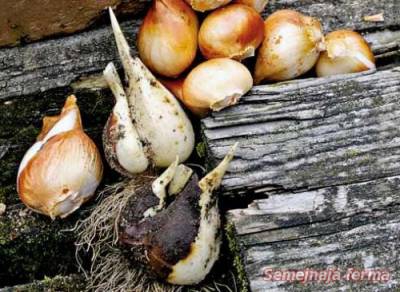

Soil preparation.
The landing site must be prepared in advance. In August, the area allocated for planting bulbous crops is dug to a depth of half a shovel. After that, enough time should pass for the dug soil to sink. Otherwise, the bulbs will be planted shallowly and may freeze out in a harsh or little snowy winter.
In addition, in the process of digging the earth, it is enriched with organic fertilizers, which must be assimilated by the soil before planting the bulbs. Humus (with a distribution of 10 kg per 1 m2) and potassium-phosphorus additives are used as fertilizers. It is much easier to use a ready-made mineral complex with minimal nitrogen impurities (consumption rate 60 g / m2).
Planting bulbs in fluffy, moist and fertilized soil while warm weather persists will promote root formation. Thanks to this, they will be able to take root in a new place before the onset of cold weather and freezing of the soil. The development of the soil by root shoots occurs to a depth of 20 cm.
Landing dates
The most common mistake of florists is the simultaneous planting of all bulbous crops at once. This process should be carried out in a planned and phased manner, taking into account the individual preferences of each of the plants.
On the verge of summer and autumn, the very first to plant small-bulbous: mouse hyacinth (muscari), crocuses, scilla, chionodox, pushkinia, etc.
The depth of introduction of bulbs into the soil, first of all, depends on their size. Typically, this is equal to three times the size of the bulb. So, the optimal planting depth for a bulb with a diameter of 3 cm becomes a 9 cm hole. A protective layer of soil of this thickness will provide sufficient protection from the cold.
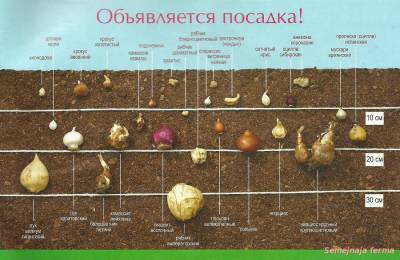

In addition, the mechanical composition of the soil affects the optimum depth of the bulb's penetration into the soil. On light, breathable soils, it is deeper than on heavy loams.
When planting, it is necessary to take into account the duration of the existence of the plant in one place. For example, for crocuses, this period is no more than 4 years, and snowdrop and spring white flower may not migrate for a decade. Therefore, they try to plant them in the vicinity of ground cover plants - phlox, zelenchuk, periwinkle, creeping tenacious. Perennials become excellent companions for them in mixborders. The decorativeness of spring small-bulbous ones is successfully emphasized when they are bunched in small groups (10-15 pieces) on the lawn.
From mid-September, daffodils begin to be planted. In case of belated planting, their bulbs may not have time to form a sufficient number of roots, which will lead to their death. To a greater extent, this applies to new, more capricious varieties from terry, cut-crown and other especially decorative garden groups. When planting, the bulbs are recommended to be grouped by size, this contributes to their improved development.
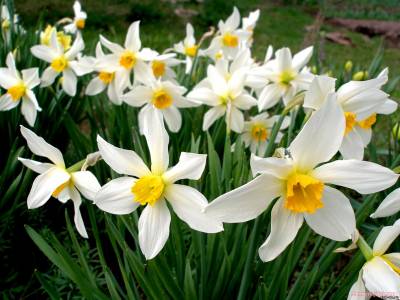

A week later, the optimal dates for planting hyacinths come. The rules are similar for them, except that they need more fertile soil. For its enrichment, the proportion of introduced organic matter is increased to 15 kg / m2.
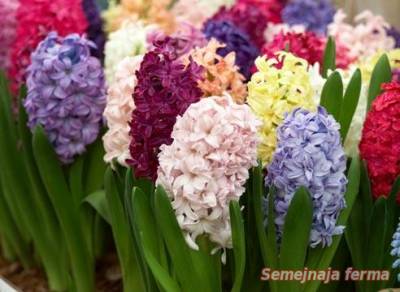

Tulips are planted at the end of September. If they are supposed to be replaced after flowering with annual plants, the planting of bulbs is carried out in a continuous way. When tulips are settled in mixborders among perennials, their bulbs are replanted at three-year intervals. At the same time, they are grouped up to 10 pieces, combining tulips of Kaufman, Foster, Greig, Darwin hybrids and simple tulips of different flowering periods. The planting of tulip bulbs should be completed by mid-October.
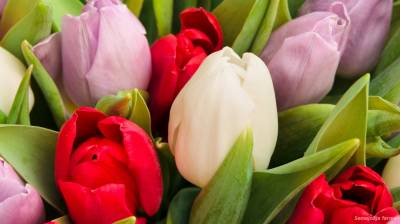

In dry autumn, planted bulbs need regular watering. Bulbs planted after rootless (dry) storage are recommended to be mulched with a layer of fallen leaves. A protective layer of mulch is also necessary for the bulbs remaining in the same place of growth.
Autumn is a hot season for flower growers. It's time to sigh sadly, remembering the past summer, and roll up your sleeves - there is still a lot of work before winter! One of the most important is the autumn planting of bulbous plants. Do not flatter yourself, believing that all you need is to loosen the earth and stick an onion into it. This is done by flower growers who do not take into account the needs of plants, but we are not like that?
Having decided to tell everything I know about the autumn planting of bulbs, I ran into a problem. Our club has brought together plant lovers from different regions - how to give universal recommendations for the inhabitants of the Urals and the Caucasus in one article? Sincerely wishing that the material would be useful to everyone, I decided to highlight the most important principles of autumn planting
bulbous. These are universal rules, knowing which, you can easily navigate the timing of planting, determine the need and other subtleties that are relevant to your region.
Landing time
On average, a bulb takes root in non-frozen ground in 2 weeks. This is where we should proceed. Surely you already know when it's time for stable frosts. Of course, Mother Nature can sometimes present unpleasant surprises - a thaw after persistent frosts or a sharp onset of winter after a long warm autumn. Don't panic, we have everything under control!
If your bulbous plants had time to sprout, and then suddenly winter came, they simply need to cover
... Lapwood, hay, straw, fallen leaves will do. This does not apply to sprouts and - they winter wonderfully under the snow.
Another variant: frost has come, and you have not yet planted bulbous
... No matter how wild it sounds, you can still plant them: there are several thaws ahead, during which the earth will warm up enough for the bulbs to take root. This can be done if the soil is not frozen to the planting depth. This is the way for those looking for early spring bloom.
If the timing of flowering is not important, plant the bulbs in the spring, they are. The value of the autumn planting of bulbs is that it allows you to get the earliest flowering. By the way, if in the fall plant the bulbs at intervals of 5-7 days
, then in the spring you can get a flower bed that blooms continuously for a month, or even longer! Try it - the result will pleasantly surprise you. Moreover, you can use bulbs of the same type and variety - the planting time will delimit the time of their flowering.
Outcomes
If you plant flowers according to all the rules, then in the spring they will certainly delight their owners. After all, these are the very first large flowers that begin to bloom after a long and cold winter. And for this, it is very important to plant the bulbs of these flowers at the right time, choose the right date that will correspond to the weather conditions in the region.
The gardener must also take into account that in frosty and snowless winters, bulbous plants often freeze out, therefore, it is recommended to mulch the planting of daffodils and tulips with a thick layer of peat, leaves, sawdust, and remove this shelter with the onset of warmth. Then all the bulbs planted in the fall will sprout, and the flower beds will look neat, without bald spots.
Bulb planting site
Again, I will give the basic principles, and you really adapt to them. What do you need to protect overwintering bulbs in the open field? From frost
, contact with
groundwater
and from excess
dryness of the soil
... What does it mean? This means that the bulbs must spend the winter in soil that is moist below their planting level and dry above them. Complicated? Far from it!
If you have planted the bulbs in a place with a high, for the winter period, make sure that precipitation cannot penetrate to your plantings. That is, cover this area with a film, shield, profile sheet - whatever you can. This method is called dry wintering
.
Keep in mind that bulbs that have been growing in a permanent place for more than one year winter better. Therefore, you should not dig up tulips, daffodils and other bulbs every year. They are can grow without replanting for 3-4 years
, this period will not at all affect the size of the plant, the duration and decorativeness of flowering.
Optimal time to process onions
The processing methods of onion sets before planting are different.... It can be both chemicals and folk remedies. For 2-3 days, the seedlings should be warmed up by air, placing the bulbs near the battery. This will help avoid the formation of arrows and inflorescences.
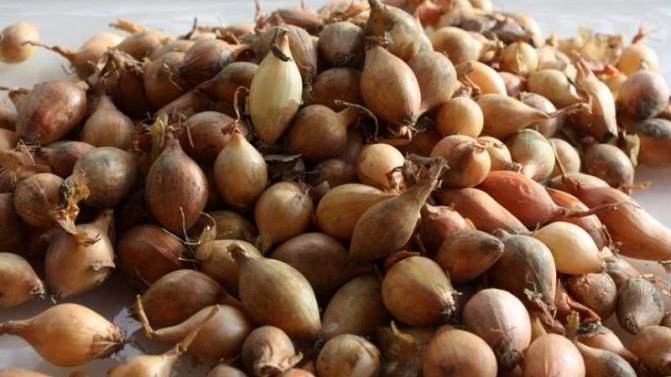

Chemical treatment is usually carried out 3-4 hours before planting in the ground. If, when choosing, you stopped at a folk remedy, then it is recommended to soak in such solutions 30 minutes before planting.
Interesting on the site:
We follow the rules of crop rotation: what can be planted after onions
How to properly water onions in the open field and in the greenhouse
Harvesting and storing onions: when it's time to dig from the garden
Soil composition
Very important, be sure to read!
Bulbous plants start growing in the fall, so it is very important that this start is successful. What is needed for this? Nutritious soil. You will have to prepare it in advance. You know that
planting bulbs in the same place is not recommended
? Of course - after all, pathogens could remain in the soil, and even treated bulbs are at risk. In order not to expose the plants to the danger of infection and to preserve their own planting material, it is better to plant them in a new place.
It should be sunny, inaccessible to strong winds, with a low level of groundwater, with fertile permeable soil. Remember about! Bulbous love slightly acidic or neutral soils
... Experts advise to prepare a place for planting bulbs in advance, 2 months in advance. Composting, adjusting acidity, adding soil loosening and moisture-retaining components - do not neglect anything! Do you want to get large plants with a full set of varietal characteristics?
So we got to the most important thing - landing. It is well known that planting depth
you need to choose this way: in loose soil - 3 heights, in dense soil - 2 heights of the size of the bulbs. As a practitioner, I can advise my planting method.
I never loosen the soil in which I plant bulbs. So I prepared it 2 months ago, during this time it rained, it thickened a little, but it doesn't matter. I make grooves with a hoe and plant bulbs in them. My principle is that the bottom of the onion should run into a dense layer of soil
... Why? I'll explain now.
I used to think that it would be easier for the roots of the bulbs to grow into loose soil, so I dug up the flower beds for planting to the depth of a shovel. How wrong I was! Look: the bulb has been planted and is taking root. It is very important not to disturb them! What happens in the case of dug up soil? The bulb has taken root, the soil is saturated with precipitation and gradually settles, the roots rise upward. What will we get as a result? Weakened plant with late development and flowering. I am already silent about its size. In general, take into account my sad experience and plant the bulbs in un-dug soil, you will not regret it.
Do the bulbs need to be processed before planting? I always use a fungicide, especially for newly purchased planting material. Another important condition for success is watering after planting
, it is needed if the ground was dry.
I tried to mention the most important principles and rules for planting bulbs in autumn. But, if you still have questions, ask! Maybe share your experience? It would be great, because there is never enough of it)
Many summer residents tend to plant bulbous flowers in the fall. They are the first to bloom in spring and delight the eye with juicy colors, delicate aroma. When is the optimal time to plant perennial bulbous flowers before winter? Experienced flower growers know the timing exactly. Their advice, reviews, videos will help housewives to complete the autumn planting work.
In the photo crocuses
When to plant tulips in the fall in the Moscow region in 2019: tips
When to plant tulips in the fall in the Moscow region in 2019: tips.
Estimated timeline: mid-Indian summer. Accurate data can be obtained by checking the long-term weather forecast. The bulbs begin to grow roots at an average daily temperature of seven to ten degrees. At night, at least plus three. In the Moscow region, this temperature usually lasts from late September to mid-October.
If autumn is delayed and the days are hot, it is better to postpone planting, in warm weather the bulbs will not only take root, but also sprout. In this case, with the onset of frost, tulips will freeze out.
When predicting early cold weather, it will be better to plant the bulbs a little earlier. After planting, it is optimal to cover with a heat-insulating material in order to maintain a comfortable temperature for the bulbs with a new warming and prevent germination.
First, the cultivation of varietal tulips requires a certain distance between the bulbs in order to better provide them with nutrients. The bulb produces "babies", plantings thicken and varietal flowers degenerate.
Secondly, the bulbs can begin to germinate at an inopportune time and the gardener risks losing all of his plantings.
Thirdly, some of the bulbs can get sick. In this case, the disease will spread to neighboring ones. It's better not to take risks, especially if you have expensive and rare varieties.
The planting site begins to be prepared a month before planting the bulbs. The place is chosen sunny and protected from strong winds. It is advisable on a hill or to make a high bed so that the water does not flood the bulbs in the spring. The soil is dug into the depths of two bayonets of the shovel.
Tulips do not grow on acidic soil, preferring slightly alkaline or neutral soil. Therefore, in the process of digging into the acidic soil, from two hundred to five hundred grams of slaked lime is introduced per square meter. Depending on the acidity of the soil.
Also at this time, well-rotted (two to three years) organic matter, ash and fertilizers are added. Per square meter in grams: ash 150, superphosphate 50, potassium sulfate 30, ammonium nitrate 25. Plus about twelve kilograms of organic matter.
After preparing the flower bed, it is left for a month (minimum two weeks) so that the earth settles and compacted. Only after carrying out these preparatory measures can you start planting the bulbs. But first you need to prepare the bulbs themselves for planting.
For flowering in the coming spring, bulbs are selected from four centimeters along the circumference. Can be three and a half. These will bloom in the spring. Smaller ones are planted to grow up until next year.
Dry bulbs should be inspected for rot. If there is any doubt about the quality of the material, it is better to remove the dry skin. Spots of rot and other diseases will be clearly visible on the white onion. If the bulb is seen to be healthy, the husk may not be removed.
Attention! Disinfection of the bulbs before planting is required.
The bulbs are pickled in a half-percent solution of potassium permanganate for a couple of hours. Since the bulbs strongly absorb water and begin to grow, they must be planted as soon as possible. It is best to pickle them just before planting.
After all the preparatory activities, you can go to the flower bed for planting flowers. If the flowers are being grown for sale and there is no need to take care of the beauty of the flower bed, you can dig grooves for the bulbs. If a beautiful garden bed is planned, then the holes will be more rational.
In any case, the bulb is planted to a depth of three times the height of the bulb to be planted. The average depth is usually fifteen centimeters. Small bulbs are not buried as deeply.
Read more: A twig in pigeons treatment of the disease is why it is dangerous
The planting depth also depends on the type of soil. In a light sandy bulb, you can plant deeper. In heavy clay, it is better to make the hole smaller so that the sprout can break through to the surface.
Important! Bulbs should not be planted very shallow. There is a risk that they will freeze out due to insufficient depth.
Mineral fertilizers are added to the bottom, if they were not introduced into the soil during digging, and sprinkled with a two-centimeter layer of sand. Onions are spread on the sand at a distance of ten centimeters. When planting in rows, the aisles are spaced twenty centimeters apart. The holes are dug at the required distances from each other.
Attention! It is impossible to press down on the bulbs when planting, so as not to break the roots that have nailed.
After placing the bulbs, they are covered with soil prepared for tulips, lightly tamped and watered.
It is better not to plant tulips in peat. Peat is an acidic soil. Liming is necessary to neutralize acidity. Further actions are standard.
Bulb baskets today can be chosen in different sizes and shapes. The smallest is eight centimeters in diameter. The largest is twenty-seven. Rectangular and square baskets are sold.
They are good in that they minimize the process of digging out the bulbs, and also protect against losses. If a certain variety is planted in the basket, then the bulbs of this variety will not be confused with the bulbs of the neighboring one.
As for the "capacity" of the baskets, it depends on their size. In the smallest, you can plant only one large onion (maybe you managed to get a rare variety in a single copy). The largest can hold up to ten large bulbs.
Planting in a basket is not difficult. It is enough to dig a hole of suitable size, place a basket there and sprinkle the bottom with prepared soil. It is necessary to sprinkle the bottom so that the tulip bulbs can be stably placed in an upright position. Then carefully cover the bulbs with soil and water.
After the bulbous flowers have faded, it is even easier to remove the basket.It is enough to pull it out of the hole and put it in a suitable place for the bulbs to ripen.
If it is not possible to buy special baskets, you can use other plastic containers: boxes for vegetables, buckets, pots, and the like. This raises certain questions about the depth of the landings.
Box for vegetables. It's simple. In fact, this is the same basket for bulbs, only of a much larger size. There are more varieties of boxes than varieties of special baskets. You can choose the most suitable one. It is better to pick it up not in the net, but "live", so that you can understand whether the box will withstand extraction from the pit along with the soil.
The height of such a box is ten centimeters on the long side and fifteen on the short side. Whether to plant large bulbs in it and bury it completely or plant smaller ones and leave some to stick out, it is up to the gardener to decide. Bottom dimensions 0.5 x 0.3 m.
Everything is done in the same way as with the use of baskets. In the case of a too deep box, it either does not need to be buried to the top (it will stick out ugly), or act in the same way as with a bucket.
Bucket. They make holes in the bucket, dig a hole of the required size and place the bucket there. The soil is poured so that three times the height of the bulbs remains up to the upper edge. Place the bulbs and add soil to the top.
Pots and plastic bottles. Plastic seedling pots and PET bottles are similar in size to each other. The difference is that you have to make holes in the bottles. And in the pots they are already there. You can grow one large onion in them or four to five small ones. Bottles must be cut to the desired size, that is, fifteen centimeters from the bottom. Planting tulips in the fall in the suburbs in a container and to what depth
If you want to grow the "children" obtained from the already purchased varietal tulips, then such bulbs should be planted from the south side so that the flowering plants that have grown do not obscure the sun for them, and the bulbs can gain strength for the next year. Otherwise, planting small bulbs follows the same rules as planting large ones.
A source.
A source
08/02/2018 3,623 Views
Since the first tulip appeared in Europe, many varieties have been bred, and it has become easier to divide tulips into groups rather than varieties. The downside of these very beautiful plants blooming in early spring is the need for their annual replanting.
Without it, the tulip degenerates and loses its grade. As a general rule, tulips are planted in autumn and only in exceptional cases in spring. But the specific terms vary depending on the region.
Planting tulips in the fall in the suburbs usually takes place in the middle of autumn.
When to plant bulbous flowers in autumn?
Bulbous perennials are planted on the site in September, October or November. It all depends on the chosen flower and weather conditions. The main requirement that must be taken into account before planting is that the bulb must have time to take root before the arrival of the first frost.
The technology of planting bulbous perennials is simple. Experienced florists recommend observing the following technology, namely:
- The planting material is pretreated in disinfectant solutions and growth stimulants. For disinfection of rhizomes, you can use a weak solution of potassium permanganate. Increasingly, flower growers prefer modern disinfectants. The drug "Fitosporin" destroys most of the dangerous bacteria and fungi. Epin has proven to be effective as a growth promoter.
- Perennials are planted in a prepared area. It is dug up together with organic and mineral fertilizers. The introduction of a small amount of sand into the soil will make the soil more permeable, loose.
- Planting depth, the distance between the bulbs depends on the flower and averages about 10 cm.
- The plantings are moistened.
The planting time of bulbous perennials is different for each plant. Florists advise planting your favorite flowers at the following times:
- the last decade of August - muscari, scilla, daffodils, chionodox, pushkinia, kandyki, corydalis;
- September - tulips, lilies, white flowers, crocuses, camassia, freesia, forest anemones;
- October - hyacinths, decorative onions.
How and how to process onions before planting before winter
Seed onions are processed before planting in the ground.... The treatment is carried out in order to prevent diseases and pests.
"Fitosporin"
Treatment with "Fitosporin" has a disinfecting effect... "Fitosporin" is a biological product based on microorganisms, which has a prophylactic purpose against fungal and bacterial diseases. Systemic drug. This means that after getting on the crop, it spreads through the vessels of the plant and begins to cure diseases.
"Fitosporin" prevents bacteriosis, peronosporosis, various types of rot... The biological product does not have a harmful effect on pests; it is available in the form of powder, paste and liquid. Dry and pasty mixtures are pre-soaked in water for two hours.
Important! It is recommended to use filtered water for preparing the mixtures. In chlorinated water, the bacteria that make up the drug will die.
For solution preparation from the powder take 10 g of the mixture per 500 ml of water.
The paste solution is prepared in two stages.:
- To begin with, make a concentrate at the rate of 100 g of paste per 200 ml of water. The main thing in preparing a concentrate is to keep the proportions 1: 2.
- Final solution: 3 tbsp. l. concentrate per 200 ml of water.
A solution of liquid "Fitosporin" is diluted at the rate of 10 drops per 200 ml of water.
The ready-made solution is sprayed on the bulbs before planting or soaked 2 hours before planting in the ground. There is no need to rinse the bulbs after processing.
Important! Treatment with the drug is carried out either indoors or in cloudy weather. Do not allow direct sunlight to hit the solution - this can lead to the death of the bacteria that make up the drug.
Potassium permanganate
Potassium permanganate processing is popular among summer residents. She is has an antiseptic effect.
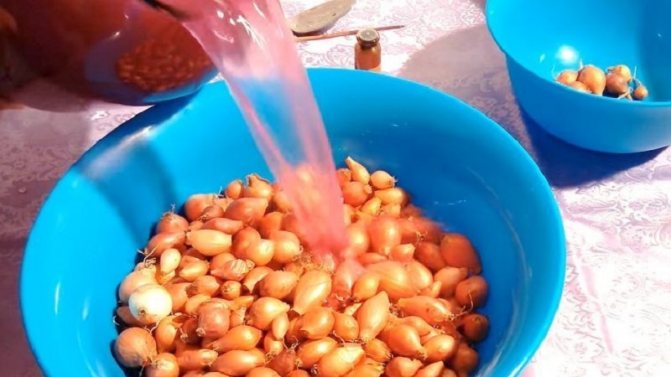

Useful properties of potassium permanganate solution:
- protects seed from wintering pests;
- helps prevent infection with fungal diseases;
- serves as a foliar fertilizer, accelerates the rooting of bulbs.
A weak solution of potassium permanganate is required to soak seed onions.: 1 g of powder in 1 liter of water. Onions are placed in the resulting liquid for 30 minutes, then planted in the ground.
Important! After processing with the solution, the onions are not rinsed or dried.
Salt or soda solution
Dthe main advantage of this method processing - its cheapness and availability.
Saline treatment prevents infection with stem nematodes, onion nematodes and fungal diseases.
For saline take 1 tbsp. l. table salt per 1 liter of water. Soak the seed onions in the resulting liquid for 10-20 minutes. Salt is sometimes substituted for baking soda. The rules for preparing a solution from soda are the same.
Copper sulfate
Copper sulfate is produced in powder form. The substance is blue, odorless. Has a disinfecting effect.
Copper sulfate treatment prevents fungal infections of the culture.
Important! The substance is poisonous.
When preparing a solution from copper sulfate take 30 g of powder per 10 liters of warm water, mix thoroughly. Onion sets are soaked for 2-3 hours in the resulting liquid, after which they are dried and planted in the ground.
Ash
Wood ash mortar - natural growth stimulant... It contains a large number of useful chemical elements.
Ash solution treatment hinders education cervical rot, fusarium rot of the bottom, green mold rot, aspergillosis.
To obtain a solution in 5 liters of water dissolve 250 g of wood ash. The onions are soaked for 5-7 minutes in the resulting liquid.Then it is dried in the open air for 2-3 hours. The onion is ready for planting.
"Epin-Extra"
"Epin-Extra" - it is a plant-based phytohormone... Helps the plant adapt to climatic conditions, serves as a top dressing.
Beneficial features:
- helps the plant cope with stress factors: temperature changes, frost;
- stimulates growth and development;
- strengthens the root system;
- helps to build green mass.
For solution preparation from "Epin" 5 drops of the drug are diluted in 0.5 l of water. Dip the onion for 10-15 minutes, then plant it in the ground.
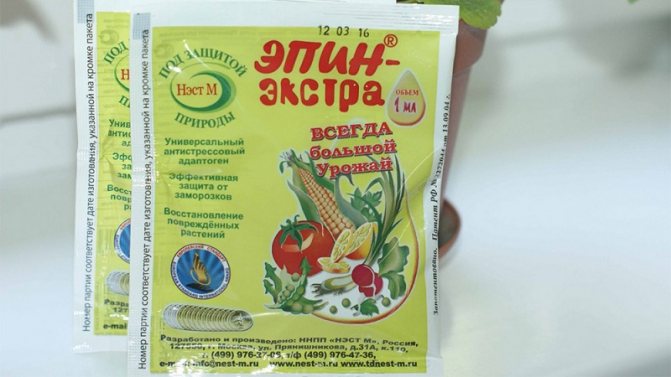

Ammonium nitrate
Ammonium nitrate solution has a disinfectant effect... It is used against pests, diseases, strengthens the root system.
To prepare the solution, use warm water. Take 3 g of ammonium nitrate per 10 liters of water, soak the onion for 10-15 minutes.
Birch tar
The use of a birch tar solution is a folk remedy and does not cause any harm to humans and nature. Has an antiseptic effect.
The use of birch tar prevents the appearance of fungal diseases, putrefactive bacteria, and onion flies.
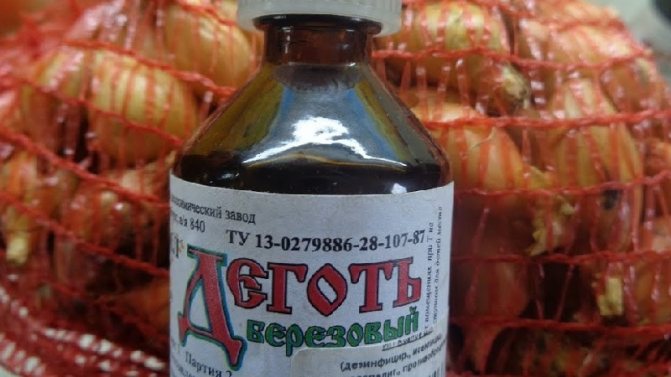

The day before soaking, the bulbs must be warmed up at temperatures up to + 38 ° C. The solution is prepared at the rate of 1 tbsp. l. tar per 1 liter of warm water. Lower the onion for 2-3 hours, stir occasionally.
Important! Before soaking, remove the old husk from the onion and cut the top off.
Kerosene
Kerosene has an unpleasant pungent odor, due to which it scares off onion flies and other pests.
Kerosene-based solution: 1 tbsp. l. kerosene per 5 liters of water.
Important! Onions are not soaked in a solution of kerosene.
With the prepared composition, spill the soil prepared for planting onions.
Bulbous flowers perennials: photo with name m
Crocuses are beautiful and unpretentious flowers for the garden. They bloom in blue, lilac, white, and their shades. Saffron bulbs are planted on site in the fall in nutritious, loose soil.
Snowdrop - perennial bulbous plant
Snowdrop or snowdrop is a perennial herbaceous bulbous plant of the lily family. It blooms in blue, bright blue, purple, white. Their stem is leafless, and the perianth is bell-shaped. They are among the first to bloom in early spring.
Chionodox blooms in early spring
Chionodox is an unpretentious flower from the bulbous family. The early Chionodox varieties bloom in April, and the late ones in May. Do not need care. They bloom in white, pink, lilac, blue flowers and their shades.
In the photo is a hyacinth. Its bulbs are planted in September - October.
Hyacinth is a fragrant flower of the Asparagus family. It is a perennial plant. Florists at the site in late September - early October.
In the photo lily of the valley
Lily of the valley is a flower listed in the Red Book. Its summer residents are planted on the site in mid-November. Propagated by dividing rhizomes.
In the photo there are imperial hazel grouses
Imperial hazel grouses bloom in white, red, yellow and orange. Propagated by dividing the bulbs, which are planted on the site in October. Grow well with minimal maintenance.
In the photo lilies
Lilies are popular bulbous perennials that are not inferior in beauty to roses. Planted on the site in the first half of autumn.
Where tulips are grown in the Moscow region
There is a greenhouse in the Moscow region, which is located in Kotelniki. The enterprise LLC "Greenhouse Plant" supplies the most beautiful tulips throughout Russia. The workers of the plant grow flowers hydroponically, which consists in placing flowers in water with fertilizers. This technique is less costly and demanding to maintain than crop growth in the ground. The grown products of the enterprise are sent to such large cities as Omsk, Moscow, Arkhangelsk and many others.
The enterprise has 3 conveyors, they carry out the following processes:
- separation of the bulbs from the stem;
- shortening of long stems;
- packing conveyor on which bouquets are formed for further storage.
Did you know? Tulip petals can be eaten. They are used in many dishes instead of onions.
When to dig the bulbous ones?
If you are faced with the need to transplant bulbous flowers, it is important to correctly determine the moment when they can be dug up.
A prerequisite is that the aboveground part of the plants must completely wither. After the end of flowering, gradually stop watering the bulbs and wait until the leaves and stems completely die off. When the plant turns yellow, it means that it has finally stopped growing and is ready to be dug up. Until this moment, it is impossible to cut off, break off, bend to the ground the aerial part of the bulbous ones - this weakens the bulbs.
If the sight of wilted, yellowed foliage does not inspire you, and your hand still reaches for garden shears, try planting bulbs in mixborders or containers with perennial or annual flowers next season. Then the wilting of spring primroses will not be so striking.
It is also important to consider that the digging is carried out only in dry weather. If the bulbs are removed from damp soil, they can rot during storage.
Benefits of autumn planting
Many experienced gardeners prefer the autumn planting of even those bulbous plants that can be planted in spring, because:
- it is more easily tolerated by them in a cool season, when there are fewer pests (insects, rodents) and pathogenic bacteria, and the soil is still warm enough for the roots and underground shoots to germinate;
- during this period, there is a natural stratification of bulbs in the soil, which has a beneficial effect on the endurance and strength of plants;
- these flowers are not afraid of spring frosts after thaws, because they had time to harden;
- with autumn planting, growth and abundant flowering in spring begins earlier than usual;
- there is a lot of rain in the fall, providing sufficient moisture to the soil and planting of bulbs does not need to be watered until they start;
- at this time, you can profitably buy high-quality onion specimens on sale;
- in the fall, when the crops are harvested and garden work is completed, more time to take care of the flower beds.
Do you need self seeding?
Many bulbous plants can self-propagate. On the one hand, many summer residents like this, but on the other hand, this chaotic and involuntary spread of plants can disrupt the pattern of the flower garden you have created.
If you do not need self-seeding, then remove wilted flowers as soon as possible. At the same time, the leaves should be left as much as possible.
This way you can control the number of bulbs and create favorable conditions for the accumulation of nutrients for future flowering.
Preparing for winter
The well-groomed grooves give the tulips a perfect approach to grooming. If there is no rain in the autumn, the tulips are watered. As soon as the first frost is foreseen, the plantings should be mulched. Various materials are used as mulch: straw, fine bark, sawdust, peat. In winter, a layer of snow is poured onto the flower bed.
Tulips sometimes do not live until spring - they are eaten by rodents. This must be taken care of in advance. It is worth planting "neighbors" that mice are afraid of - daffodils, fritillaria.
Perhaps this will interfere with the conceived composition, then kerosene is used as a protection. All bulbs are placed in a bag and sprayed with a foul-smelling agent. After 30 minutes, a film forms that is harmless to plants, but scares off rodents.


Other protection measures:
- Vishnevsky ointment". Each tuber is processed.
- Ground red pepper. Mix with soil and place around the tubers.
- From mechanical means of protection, containers with small cells are used.
- Metal meshes are made independently. The cells should be 6-7 millimeters long.
- They are planted in a bucket. Only stored in severe frosts in unheated rooms.
Why didn't the bulbs bloom?
There may be several reasons why bulbous plants did not bloom. We have already described some of them above.
1. Flowers need replanting. Perhaps you have not transplanted bulbs for a long time, or the flowers have grown a lot and they are simply cramped. Return to # 6 and follow the transfer directions.
2. You transplanted bulbs from containers. As we explained above, bulbous plants do not always bloom the next year after distillation.
3. Bulbous plants grow in the shade. Most bulbous flowers need good lighting for good growth and beautiful flowering. Perhaps the reason lies in the fact that the planting is shaded by a large tree or shrub.
4. Plants lack nutrients. Probably, the soil on your site is poor, and without feeding the flowers are starving.
- Flowers of lilies are getting smaller - what to do?
5 possible reasons for lily flowers to become shallow.
We hope we have been able to answer the most common questions regarding planting and storing bulbous flowers. If you still have questions, do not hesitate to ask them in the comments to this article or on our forum.
We suggest that you familiarize yourself with: Soil for lawn description soil composition peat
Tags: calendar, bulbous, bulbous, planting, flower
About
«Previous post
How to store it correctly
Store the bulbs in a cool and ventilated area (but not cold) until planting.
Bulbs of such plants as snowdrop, white flower, blueberry, chionodox, pushkinia are not covered with dry filmy scales, so we store them in slightly damp sawdust or peat in plastic bags.
Just do not forget to make holes in the bag so that there is air access. It is advisable not to overmoisten the substrate in which the bulbs are stored so that the plant does not grow ahead of time.
Bulbs of hyacinths, daffodils, hazel grouses, tulips and decorative bows are not afraid of heat and even need it. A flower bud is laid in them at a high temperature and in dryness. But here, too, one must know when to stop.
We process the onions before planting
Bulbs packaged in packages can be sold with signs of infection with penicillous rot. If the spots are small, the bulb can be salvaged. Also, under the integumentary scales, you can see spots with a bright border - a sign of fusarium. The lesions must be cleaned and the sawn-off should be sprinkled with activated carbon or powdered fungicide. The cut should be given 3 days for drying and corking. Before planting, the bulbs can be disinfected with a complex preparation for seed dressing.
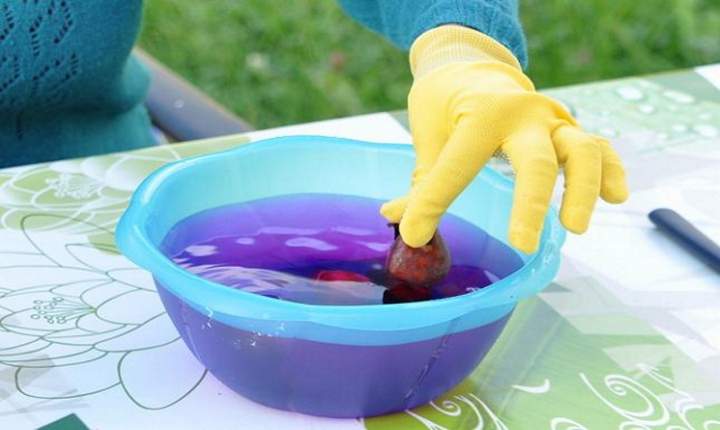

Popular views and photos
Tulips
Are the most frequent guests in all flower beds. Tulips are loved for their ease of care, they are unpretentious, but very beautiful. There are many varieties of tulips, as well as their colors. Already in early spring, they pleasantly surprise us with their flowers.
Hyacinth
- this plant has an impressive range of colors. Hyacinths come in white, pink, yellow, blue, and purple. They look very impressive in flower beds, they can be grown in a container. They bloom mainly in April and also in May.
Lily
- every person knows this delicate flower, because they decorate not only gardens, but also residential complexes, perfectly adapt to urban conditions. The colors of the lilies are different, bright and not very. The flowering time of beautiful lilies depends on the variety, most often it is June or July, but there are also autumn varieties.
Narcissus
- a very delicate and touching spring flower. Flowers can be white, yellow, or yellow-white. It blooms very early, many associate it with the beginning of spring. Many varieties begin to bloom in March and delight women on International Women's Day.
Planting bulbs in the fall is the most desirable event in many regions of our country, which is due to soil and climatic conditions.Such a planting before winter allows you to get abundant flowering next spring, and not after a year, as it happens if a spring planting is performed.
Growing bulbous perennials
Bulbous garden flowers include bulbous primroses that appear with the arrival of spring, crops that bloom in summer and autumn. The bulb (underground part) is responsible for the development of plants. Among the perennial bulbous crops are:
- corms;
- small-bulbous;
- bulbous.
Many gardeners prefer the bulbous flower with long narrow leaves when cultivated in the country. When growing plants, emphasis is placed on:
- Planting bulbous crops in a group. Separate planting of 1 or 2 plants will not add much beauty to the garden bed. Planting 15 bulbs in various shades will become a bright spot in your front garden.
- Planting bulbous perennials under large, spreading trees. Before flowering, the trees will not have time to be covered with thick leaves, the bulbs will receive the necessary amount of food and lighting.
- Digging tubers for the winter. This applies to gladioli, begonias. Lilies are left for wintering in the soil.
- The depth of planting bulbous, which is 3 times the height of the individual.
- Storage of planting material. The dug out bulbs are disinfected in a solution of potassium permanganate and dried. To preserve the bulbs, use paper or canvas bags, cardboard boxes. Bulbs without mechanical damage are stored in slightly damp peat.
- If you want to create a bulbous flower bed, small bulbous low-growing crops are planted in the foreground: muscari, freesia with shades from red to purple tones. In the background, there is a place for large-bulbous tall plants.
Choosing a site for planting and preparing the soil
All bulbous plants do not like excess moisture very much. And therefore, the best soil for them is considered to be medium-heavy and moisture-permeable.
Bulbous plants can also be planted on sandy soil, as it is water permeable. But first it is necessary to increase its fertility by adding nutritious soil or compost to it.
If your soil is too dense, then in order to avoid stagnant water and, as a result, rotting of the bulb, it is necessary to create an additional drainage layer in the planting hole.
To do this, pour coarse sand, crushed stone or gravel into the hole. The layer thickness should be approximately 4-5 cm.
To prepare the heavy soil for planting bulbs, you need to dig it up properly, while adding coarse sand or compost.
And one more important condition, in no case replace compost with fresh manure! This usually leads to fungal diseases of the bulbs.
When to buy planting material
When is the best time to buy flower seeds
During the winter, the choice of seeds in flower shops is much wider than at any other time. You can also purchase seeds through a specialized online store, having previously found out how many years it has existed and inquired about its reputation. Give preference to the store with more experience and experience in the market. Do not buy seeds from those traders for whom they are only an accompanying product - in such a place you will not receive the information you need, or a reliable guarantee. But the main thing is not where and when you buy a bag of seeds, but what is the shelf life of these seeds and the availability of recommendations for growing flowers on the bag.
When to buy flower bulbs and seedlings
It is best to purchase planting material just before planting it, but this is not always possible. Summer bulbs and tubers are usually sold at the end of winter, so consider where and how you will store them before planting. It is best to place them in peat or sand and keep them at or below 7 ºC in a basement or refrigerator. Better yet, plant the bulbs in a container in order to transfer them to the open ground when planting time comes.Never buy bulbs of spring-flowering crops in the spring - daffodils, hyacinths, crocuses and tulips, as there is a high probability that they have been stored in the warehouse since autumn, which means that their shelf life has already expired, although by the appearance of the bulbs this may not define.
Rose seedlings usually go on sale in February and should be stored in a cellar or refrigerator at freezing temperatures until planting. On occasion, the purchased rhizome perennials are best placed for storage in the refrigerator. It is preferable to buy peony planting material in late summer - early autumn, but it usually goes on sale in late winter or spring. Before buying such material, carefully examine it for the presence of mold or rot on the roots, since it could have been stored incorrectly before sale, and if you nevertheless decided to buy peony seedlings, then pickle their roots for half an hour in a fungicide solution or in a very strong one, an almost black solution of potassium permanganate. Then store the seedlings at about 0 ºC.
- Back to
- Forward
After this article, they usually read
Planting tulips. Preparatory process.
In central Russia, these flowers are planted on the border of the first two autumn months.
Soil and fertilizers
The soil chosen for planting tulips in the fall should not be overloaded with organic fertilizers. For example, even a little manure can lead to decay of the roots and damage to the bulbs. Other substances can distort the flower stalks or the shape of the buds. On the other hand, green manure and disinfected compost have a positive effect.
Fertilized neutral or alkaline soil should be plowed and then fertilized with mineral matter. When preparing for planting in flower beds, humus should be added to the soil, 2-3 months before planting.
In countries that industrially produce tulips, such as Holland, organic fertilization was previously considered harmful, but a small amount of humus has been shown to have an excellent effect on flower growth. Also, when planting tulips, they like to use mineral fertilizers, which extend the flowering time and increase the strength of the stems.
Treatment
Bulb seeds of tulips are treated with special substances that increase their resistance to diseases and protect them from harmful insects. Proper care of the bulbs before planting is the key to future seedlings, their size and health.
Any processing can be divided into 4 steps:
- Divide the bulbs into groups by size and variety. This step is optional, but it makes it easier to create even beds.
- External evaluation of seeds. The top of the husk should be removed from each onion, after which they should be examined and felt for damage or disease. Bulbs unsuitable for planting can be placed in the ground, but only in a separate box, from healthy ones, or at a distance of several meters, when planted in the ground.
- Treatment for decontamination. The seeds are sent to a hand-made manganese solution. Store solutions may contain substances that kill both parasites and planting soil.
- Planting bulbs in the ground. Each seed must be placed in the ground immediately after processing, without allowing it to swell. Overflowing with moisture, they become brittle.
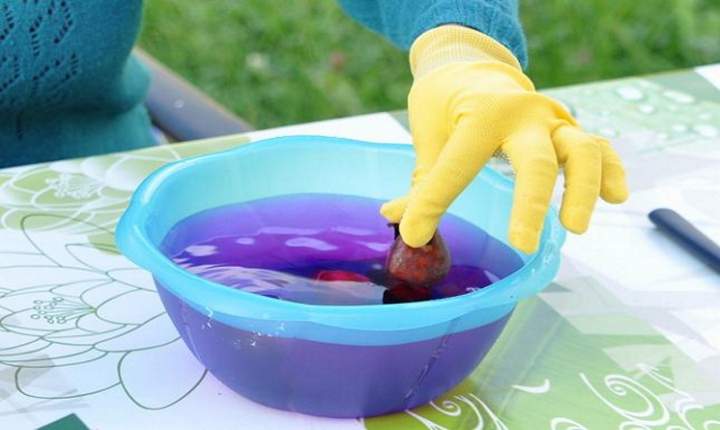

Instead of manganese, foundazol, vitaros, epin, karbofos can be used. When creating a solution, it is necessary to observe the proportions: manganese - 2: 10000 (g / ml); foundazol - 30: 10000 (g / ml); vitarosa - 20: 10000 (g / ml); karbofos - 20: 10000 (g / ml); epin - 1 drop in 2 liters of water. In addition, for substances, the soaking time is different - 30 minutes for everyone, but an hour for a foundation and a day for an epin.
More about boarding
Cultivation begins, depending on the growing area, from early September to mid-November.Depending on the variety, the plants should be expected to take root before the first frost. A soil temperature of about 10 degrees Celsius is considered the best for planting, and 5 degrees is the most favorable for growth, in addition, the ground must be sufficiently moist.
It is advisable to plant tulips according to varieties, from early to later. The beds should be a dozen centimeters or more high to reduce the amount of liquid in the ground. In warmer areas, you can reduce the altitude. The bed is more than a meter wide, with indents of 40 centimeters from each other. In wet, swampy areas, it is necessary to raise the ground level.
On the ground, cross marks should be made every 20 cm, then pits should be made with a shovel, with a depth of the same size. River sand should be poured down, you can mix it with peat in equal proportions. The bulbs are placed on this mixture, pushing them a little deeper, after which the pits are filled up. To separate the varieties, the interval between the pits should be increased to half a meter. The holes are made in the same way, regardless of the total number of seeds.
When creating holes, it is better to remove the previously fertilized soil in a separate pile. Thus, the bulbs can be covered with soil, without the need for separate fertilization.
For heavy soils, mix soil with humus. For every square meter, you need at least 10 kilograms of organic matter. Mineral fertilizer can be added to the same mixture in full. The bulbs are laid on the sand in the same way, but not pressed, and then covered.
For large plantations, the furrow plowing method should be used. Generally, planting in grooves will produce a large number of bulbs suitable for growing in the next year. Between the beds it should get 50-60 cm, and between the seeds - 12-15 cm. Also, this planting method allows you to automate the care of flowers.
The depth is influenced by the composition of the soil. For light soils - deeper, for humid climates - less. Also, a well-warmed and warmed-up soil requires small beds. At the end of the planting of flowers, the soil should be mulched with a small layer of humus. To protect against drying out, you can use grain husks instead of humus.
Most of the soil needs fertilizing. Nitrate, ammonium and potash, phosphates and wood ash can be used as fertilizers. Fertilizers are distributed as follows (per square meter): 10-12 grams of nitrate, 50 grams of phosphate, 40 grams of potassium sulphide, 0.2 kg or more of ash. The distributed fertilizers can be scattered rather neatly, and in the early stages of growth, while the bulbs are still deep, you can dig up.
When is a transplant required?
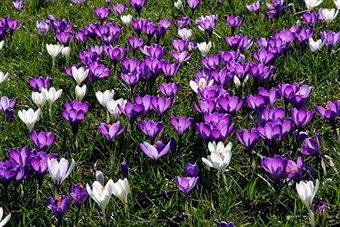

Bulbous plants can grow in one place for several years. The need for transplanting arises if the nests of the bulbs have already grown too much and interfere with each other, and the feeding area becomes insufficient and the flowers will be much smaller.
Rapidly propagating plants (crocus, blueberry, chionodox, muscari) must be transplanted for 3-4 years.
And, for example, hazel grouse and kandyk, breeding slowly, can grow without transplanting in one place for 6-8 years.
Plants can be transplanted only when the aerial part dies off completely.
The dug out bulbs must be cleaned of old scales and roots and laid out in one layer in a dry, well-ventilated area.
Until next time, dear readers!
Choosing good bulbs for planting
It is better to choose flowers with large bulbs when buying. First of all, they must be tight, free from damaged areas and free from the smell of mold. It is necessary to take a good look at the bottom of the onion. A well-dried and dense bottom is a guarantee of a healthy plant. In small flowers, the bulbs are smaller.
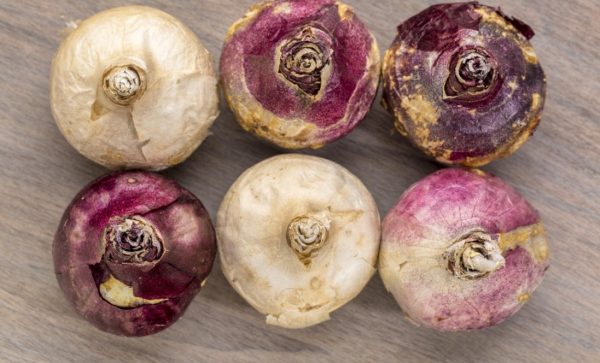

In hyacinths, the color of the bulbs covering the scales is similar to the color of future inflorescences.
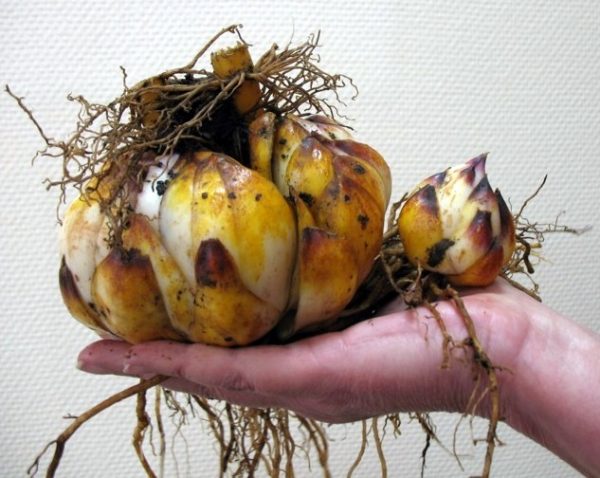

It is dangerous to acquire lily bulbs if they are sprouted. They are running out of nutrients. In the following year, such flowers will not have the strength to bloom.
How to feed bulbs?
Florists' advice on feeding bulbous plants varies.
Some add bone meal or a complex fertilizer of prolonged action immediately to the planting pit. Others add rotted compost or manure during flowering. Still others feed the bulbous with complex potassium-phosphorus fertilizer in early spring.
Be that as it may, all these agricultural practices give good results. It remains only to choose the option that is most convenient for you.
- Spring feeding of bulbous
How to properly feed perennial bulbous plants so that they please with colorful multicolor.
Autumn planting of bulbous, small-bulbous and corms
Add to this minimal maintenance: watering is required only at the beginning and at the end of the season, by the middle of summer the foliage of the bulbous dies off.
When to land
Bulbous plants can be planted from September until the end of October, but not earlier. If there is a long autumn and the bulbs in the soil are warm and humid, they will confuse winter with spring and begin to germinate. The sprouts will beat the first frost, and in spring the flowering will not be so amicable. Two weeks are enough for bulbous rooting. So it's better later than before.
Focus on the temperature of the soil - it should not exceed 10 °. Be sure to inspect the bulbs before planting. If you notice dents or cracks, soak the bulbs in a solution of potassium permanganate. Rotten ones - throw them away without regret, otherwise they will infect all flowers.
Without exception, all bulbous plants love open, sunny places and fertile, well-drained soil. The peculiarity of these plants is that in the spring they need moisture for a good start, but bulbs do not like strong moisture either, they can rot.
Don't forget the acidity! Bulbous ones like slightly acidic or neutral soils with a pH level of 5-7. If your soil is poor; add compost to it before planting, and fill the heavy, clayey one with coarse sand.
How to make landings
On the package, the planting depth is usually indicated in centimeters, but measuring the hole with a tape measure with frozen hands is not very pleasant. Follow the popular rule of three. It sounds like this: the planting depth of the bulb is three times the height of the bulb itself. That is, three onions placed on top of each other should fit into the prepared hole. Accordingly, the smaller the onion, the smaller the hole.
However, this rule works if the soil is loose. When it is heavy, you need to plant the plants two bulbs deep to make it easier for them to germinate in the spring. It is curious that some bulbous plants themselves can correct your mistake: if, for example, you buried snowdrops too deeply, then they form babies already at the correct depth.
Compact the bottom of the hole before planting and throw a handful of sand into it so that the bulb stands on a hard, dry area. Mulch the planting site with peat, straw or leaves.
What flowers to plant in autumn
Bulbous plants bloom in turn, as if passing a baton to each other. Get to know the most unpretentious of them and plant the ones that you like best.
Galanthuses (snowdrops). They are the first to literally crawl out of the snowdrifts. The sight is very touching, so it is worth planting at least a few copies in front of a window or by the path, so that you can always admire them. Do not plant many plants, as galanthuses bloom for only a few days. It is a good idea to place them together with roses: they will overwinter with them under the same shelter and will bloom even earlier.
Crocuses. These flowers take over the baton from the snowdrops. Today, not only their botanical natural appearance is on sale, but also many varieties with large white, purple and yellow flowers.Plant them more densely, in glades or in the tree-trunk circles of apple trees, then the spectacle will be even more spectacular. If you accidentally dig up a crocus in the spring, don't worry. This small onion will bloom anyway, it is so unpretentious.
Muscari (mouse hyacinth)... Indispensable for a spring garden. They bloom with blue and white flowers. Stop at Armenian Muscari and its varieties. Plants of rarer species may be larger and brighter, but they are very delicate and reproduce slowly. These plants look great in large groups under trees, on lawns, in curbs. They reproduce quickly by self-seeding, so they can easily go for a walk around the garden uncontrollably. If you don't like this, cut the stems after flowering.
Tulips. Established kings, blooming from April to early June. Few bulbs compete with them in terms of a variety of shapes, colors, flowering times. I advise you to plant tulips in groups so that at the end of the growing season, when the leaves turn yellow, they can be masked by other perennials. A good result is the friendship of tulips with hosts, astilbe, paniculate phlox. Their foliage grows back just at the moment when the bulbous have faded. In such mixed flower beds, tulips do not have to be dug up every year.
Daffodils. This flower, of course, can be recommended to grow to beginners, because daffodils grow everywhere and in almost any soil. Although the largest inflorescences are formed in a sunny place. If you pick daffodils and tulips of the same flowering period and plant them together, you get a fabulous picture!
Small-bulbous, most often crocuses, can be planted on the lawn. Let it be a few small but dense groups. In spring, showy yellow or purple spots will decorate a lawn that has not recovered from winter. There are two planting methods. Carefully cut and peel off pieces of sod, plant the crocuses following the rule of three, then replace the sod like a patch. Use a peg (or a piece of pipe) to make holes in the lawn, for each bulb - a separate one. Plant the onions and cover the holes with earth.
What is pre-planting tulip bulbs?
The tulip tubers are taken out of storage and the bulbs are then prepared for planting.
Pre-planting tulip bulbs includes several stages.
- The products are cleaned from hard, dry skin.
- Each copy is carefully examined for the presence of diseases, rot, lethargy.
- Damaged specimens are reanimated. Here it is up to the gardener to decide whether to soak diseased bulbs in a rescue solution or discard them immediately.
- The last stage is treatment with disinfectants right before planting.
Peeling the onions from the husk
The husk is removed on the day of planting. The top layer may contain foci of infection that are invisible at first glance. All dry scales are removed. So the plant will better absorb nutrients from the soil.
Close inspection
All tulip roots are poured onto the table after storage. Each tuber is examined carefully to detect rot, lethargy, and mechanical damage. All healthy and strong are left aside for the time being. Dealing with damaged copies. If there is a possibility, they will reanimate, if not, they throw it out.
Sorting of planting material
As soon as the tulips are peeled from the husk, proceed to sorting. Three containers should be prepared - for large, medium, small specimens.
For planting, tubers are needed large and medium. The latter are sent for growing. Of course, the work is troublesome and takes time. There is another option, without sorting - to purchase packages with prepackaged rhizomes at a flower shop.
What flowers are planted in autumn
Autumn planting has undeniable advantages:
- firstly, flowers planted or sown in autumn will bloom in the first year of the growing season;
- secondly, it will free you from the hassle of growing seedlings in the winter and save the time that you had to spend on planting them in open ground in the spring;
- during autumn and winter, the seeds in the ground undergo natural stratification, so the seedlings that appear in the spring will be strong, they will be able to tolerate spring frosts well and bloom two to three weeks earlier than those that you sow in spring;
- flowers planted in autumn are less exposed to diseases and pests throughout their life;
- in the spring, when the snow melts, the seeds of the autumn planting in the soil absorb the maximum amount of moisture, which helps them to develop quickly. Flowers sown in spring may experience a lack of moisture due to the fact that when the air temperature rises, its evaporation from the topsoil increases.
As you can see, there is enough reason to start planting and sowing flowers in the fall.
What flowers are planted in the fall?
In autumn, they planted, as well as divide and plant such bulbous plants - Pushkinia, Muscari, Scylla, crocuses, Chionodox, daffodils, hyacinths, tulips and lilies. With autumn approaching, it is time to divide and transplant astilbe bushes, peonies and host. Will grow well if planted in the fall, clematis, adonis, aconite, as well as large-leaved brunner, paniculata phlox, rudbeckia, bells, sedum, lupine, evening primrose, autumn helenium, echinacea.
Planting annuals in autumn is preferable because their seeds, having passed natural stratification in the soil in the winter months, will give flowers next year that will both grow better and bloom longer. Among the flowers that are best sown in the fall are annual asters and chrysanthemums, mattiola, calendula, marigolds, blue cornflower, godetia, delphinium, iberis, lavatera, mignonette, malcolmia, scabiosa, eschsholzia.
Tips from seasoned gardeners
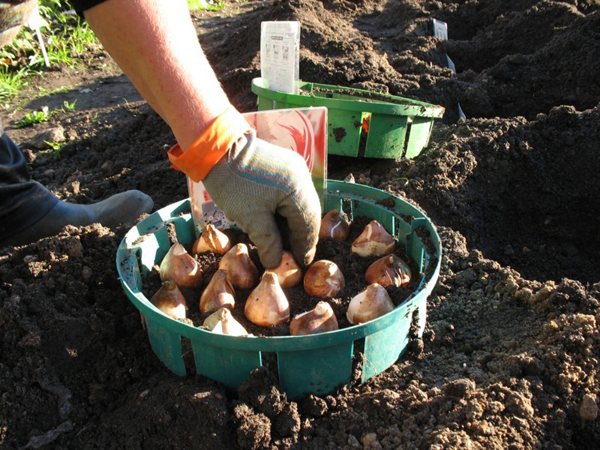

Gardeners who are fond of growing and breeding bulbous flowers give some interesting tips that will help budding growers successfully grow these crops.
- A very convenient way to plant the bulbs in a small plastic basket. Its bottom is covered with a layer of nutrient substrate, the bulbs are placed and buried to the desired depth. There are many pluses:
- no loss of bulbs;
- easy to dig up and plant;
- planting material is reliably protected from rodents and other pests.
- Bulb packaging should not be discarded after planting. If you like the variety of this or that plant, it will be possible to buy additional planting material without any problems, and not wait for the appearance of children.
The technique of placing in a basket has become very popular and is considered one of the main methods of planting bulbous flowers.
Planting bulbs in the fall in a grid and containers: video
How to choose the right one?
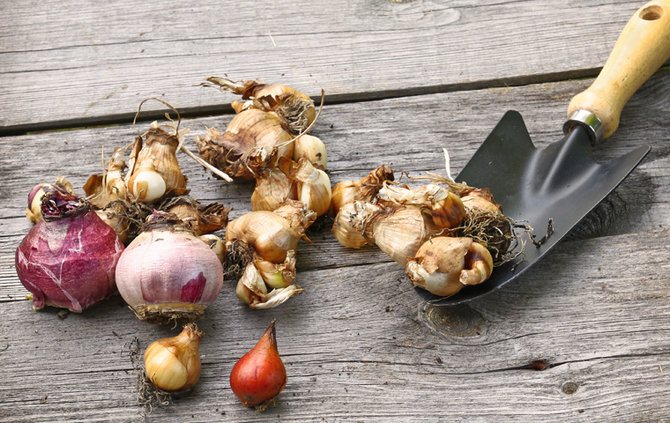

Planting material for a flower garden can be chosen according to many factors: plant color, height, aroma, flowering duration. All this will depend on the selected species, variety or hybrid of the bulbous plant. Real professionals make sure to take all these factors into account when buying seeds. But if a beautiful, attractive and unique garden plot or flower bed is more important for you, then you can purchase a mixture of planting material, consisting of different varieties and types. Usually, in such sets of flower growers' bulbs, a surprise awaits in the form of different colors and a set of plants of the same type. Even an experienced seller will not be able to say with certainty what the result will be in the spring on a flower garden.
If we talk about the choice of bulbs for quality characteristics, then it is necessary to pay attention, first of all, to their size and integrity. The planting material must be large and free from the slightest damage. When buying, it is advisable to carefully inspect each bulb. Bulbs with unusual growths, cracks, dark spots or signs of decay should not be purchased.All this may indicate a disease, and a good plant will not grow from such planting material.
Digging and storing bulbs
Tulips are dug up annually. Exceptions are baby bulbs, which remain in the ground for 2 years. What is it for: sick specimens are rejected, the appearance is improved (enlargement of flowers), the ability to give children increases.
There are a number of rules for when and how the digging is done:
- Do not miss the moment: you need to dig out tulips when the leaf is 2/3 dry. If you get the bulb earlier, then it will not have time to collect the necessary supply for subsequent flowering. Late extraction is fraught with the fact that the mother's part will go deeper into the ground, and the babies will separate from it. There is a high probability of missing or damaging the planting material.
- Arm yourself with a bayonet shovel: you must stick it deeply and with a "margin" around the edges so as not to damage the flowers.
- Change the bed every 3 years.
Now more about how to store tulips before planting in the fall. The resulting nests must be divided, freed from husks, roots, and remnants of leaves. Then they are washed (if necessary), antifungal treatment is carried out and dried. Before laying the planting material in boxes, it is necessary to sort it by grades and by sorting. Remove diseased specimens.
Successful planting of tulips in the fall in the ground depends on adherence to temperature and humidity. The bulbs are stored in boxes without a lid, placing them in 2-3 layers. They must be inspected periodically to remove decaying specimens. The storage temperature is gradually reduced: in July it is 23-25 °, in August - 20 °, in September - 17 °. Failure to comply with the temperature limits leads to the appearance of blind shoots on which a flower does not form.
If during the inspection you find rot or mold, then you can try to save the tulips. If mildew is not widespread, remove it with a dry cloth and sprinkle with ash. If the decay has gone deep, cut off the affected part with a knife. Sprinkle the cut with ash or brush with brilliant green.
Video "How to dig up and store tulips after flowering"
What else do you need to know
Do not press the bulbs into the soil with effort when planting, so as not to damage the root roller. After planting, the site should be leveled so that water does not stagnate in the landing pits.
If the autumn is dry, then the places where the bulbous flowers are planted should be watered regularly. With the onset of frost, it is advisable to mulch the planting site with compost or dry leaves. Small onion-children are especially carefully covered. They are planted closer to the surface and the risk of freezing is greater.
We are in social networks: Feel free to add to groups, write comments, read and discuss daily articles on social networks!


Is it worth fertilizing the land
Tulips can be grown without top dressing. Only in the second year will they be too different from their counterparts who are fed. The flowers will be smaller, the stem is thin, the plant is susceptible to diseases, since the immune system is weakened.
Only in fertile soil do tulips feel good, but plants greatly deplete the soil, draw out all the nutrients from it, therefore, four additional fertilizing are required in a short vegetative period - 2 months.
Flowers need a complex of fertilizers: nitrogen, potassium, phosphorus, in various proportions. Nitrogen is responsible for the growth of green mass, potassium helps to quickly take root, phosphorus is involved in the formation of buds. At each stage of feeding, one of the components is in the lead.
Microfertilizers with the presence of elements are no less important for flowers: nickel, iron, boron, zinc, manganese, copper.
Although they are required in micro doses, they bring considerable benefits to the plant:
- form a strong stem, large inflorescences;
- strengthen the immune system;
- participate in metabolic processes and photosynthesis;
- resist diseases, pests;
- increase frost resistance.
Microfertilizers are introduced using foliar feeding. The fertilizer set depends on the season. When planting in autumn, top dressing is chosen that act on rapid rooting, protection from external factors. In spring, components are needed for the growth of green mass (leaf, stem), root.
Tulips are grown at home for distillation. Here you do not need to make a lot of dressings, since another task is being performed - rooting of the bulbs. Before planting, only a solution of calcium nitrate is required to be added to the soil. The rest of the care consists in choosing a cool temperature, humidity, watering.
Longlines and Sandwiches: Alternative Disembarks
A creative approach will make any business interesting. This also applies to floriculture. Recently, unusual methods of planting tulips are gaining popularity. They save time, decorate the garden and attract attention. In addition, they are quite simple and everyone can master them.
Container planting or basket planting simplifies the tulip growing process. The essence of this method is to use baskets, containers and other containers instead of a flower bed or garden bed. They can either be dug into the ground or freely positioned in any convenient place.
The advantages of this method:
- You firmly believe that you have completely dug up the planting material. The onions themselves are minimally traumatized and, therefore, better stored.
- You create optimal conditions for plant growth. Relevant for infertile soils - it is easier to create ideal conditions in a confined space.
- Reduces the likelihood of damage to the bulbs by rodents. Mice cannot overcome the obstacle from below.
Anything can be used as a container: plastic bottles, boxes, baskets, pots and even bags. One condition - you need to make holes for the outflow of excess water. Use a red-hot knitting needle or other similar object for this. The holes should not be large, otherwise mice will make their way through them.
The second way to arrange flowers in an unusual way is a tiered planting. The essence of this method is to lay the bulbs at different depths. The very first layer, starting from the bottom, is occupied by large bulbs. The higher the level, the smaller the size. In order not to be mistaken and not to plant one flower on top of another, use long thin sticks. Stick them next to the landing site, and after the flowerpot is completely filled, remove it. This combination method is also called "lasagna" - the structure resembles this dish in its layering.
It is important to take into account the color, size and shape of the petals when drawing up such a composition. Try to play on contrasts: smooth plant with terry, red with yellow. Groups of colors combined by color will look beautiful. For example, variegated with monochromatic: the color of the blotches should correspond to the mono color of the petals of the neighboring variety. A group in which tulips are selected according to the timing of flowering will look spectacular.
Video "Methods of planting tulips"
We consider popular varieties: hyacinths and mouse muscari
Different varieties of bulbous need a certain type of soil, the amount of sunlight and moisture. The planting depth also differs. Conditions for the most popular varieties:
- Muscari. Loose, drained soil is suitable for these flowers. Muscari love sunny places, so they are not planted in the shade. The bulbs are buried to a depth of 8 cm with an interval of 10 cm between the plants.
- Crocuses. These flowers love permeable earth and sunlight. They are planted in the same way as muscari.
- Daffodils. Plants bloom well both in the sun and in the shade. They are suitable for moisture-permeable soil. Planting dates are August-October.
- Tulips. These flowers are the most unpretentious among the bulbous ones. They do not need special conditions, but at the same time their diversity is amazing. The varieties differ from each other not only in color, but also in shape. They are distinguished by the longest autumn planting period and the possibility of home distillation.
- Lilies.The soil for planting lilies is fertilized and drained. Different varieties require their own conditions for planting.
- Grouse, fritillaria. Sunlight and drained soil are important for these flowers. They are planted with an interval equal to two sizes of the bulbs. Plants of orange color are visually very similar to lilies.
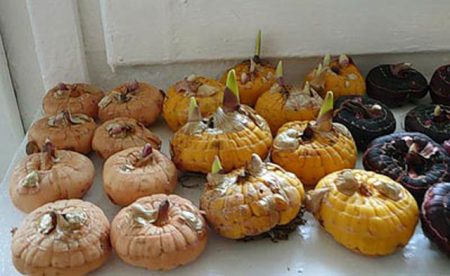

You may be interested in:
Liliaceae love loose, drained soil. It is necessary to deepen them by 8 cm, making approximately the same distance between them. The place for planting should be chosen open, because these flowers love the sun.
Muscari look very beautiful and especially delight gardeners that they begin to bloom even during the snow melt and continue to do this at a time when the trees are dressed up in a green outfit.
What is needed for abundant flowering of bulbous?
Most of our popular garden bulbous flowers are not whimsical at all, do not require complex care, and develop well on different soils. The main thing is to plant it correctly. What is important:
- choice of location;
- soil preparation;
- healthy bulbs;
- correct planting depth;
- correct boarding time.
The main requirements for planting tulip bulbs, daffodils, snowdrops, hyacinths, muscari, crocuses, and many other bulbs are soil preparation, fertilization, and healthy bulbs. Planting time is also very important.
Care
There are different opinions among gardeners on how to feed the bulbous flower. Some summer residents add bone meal or complex fertilizing to the planting hole. Others add rotted manure or compost during the budding phase. Some growers do not forget to nourish bulbous perennials with potassium and phosphorus with the arrival of spring.
Agricultural practices differ in effectiveness. The right, which option to choose, remains with the gardener.
Bulbous perennials bloom at different times, which makes it possible to make stunning continuously blooming clumps. The natural beauty of bulbous, unpretentiousness will transform the garden area beyond recognition, fill it with richness of colors.
When planting, it is important to observe the following rules:
| Plant the bulb with the roots down and the top up. If it is difficult to identify the top of the bulb, place it on its side. In this case, the sprout will still be able to hatch to the surface. Observe the recommended embedment depth. If you plant a tuber or bulb too deep, the sprout may never emerge from under a thick layer of soil. If planted too shallow, they can dry out or get sunburn. Usually, the smaller the bulb, the closer to the surface it is planted. |
If you wish, you can add fertilizer to the planting hole. We advise you to choose complexes of prolonged action, which will release the elements gradually, feeding the bulb (for example, Bona Forte summer-autumn, Phosphate-potassium fertilizer Autumn (Buy fertilizers), OMU Autumn (Buy fertilizers).
From above, the planting site is recommended to be mulched. Use natural materials for these purposes: rotted compost, foliage, dry pine needles, etc.
Algorithm for planting flower bulbs in autumn
Before planting, the bulbs of spring flowers must be sorted out, discarded damaged ones, and treated with a fungicide. It is important to remember that large bulbs will produce large flowers and vice versa. Consider this when planning your planting so that the aesthetics of the flower garden are not compromised.
Planting plan for bulbous flowers:
Remove weeds from the future flower garden. There is no need to loosen the soil. Make holes in predetermined places using a special device or glanders. Calculate the depth using the following formula: if the ground is light - 3 bulb heights, if heavy - 2. Specify the planting density for each variety of flowers separately.
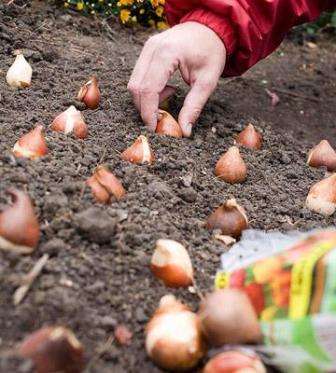

Planting density depends on the variety of flowers
Place the flower bulb with the bottom down, sprinkle with earth and compact a little. If the soil is too dry, lightly moisten each hole.
Planting Bulbous Flowers for Winter Bloom - Forcing
Forcing is a process aimed at obtaining buds by a certain period. This is achieved by accelerating the imitation of three natural stages: a period of rest, cooling and awakening. By calculating and implementing each stage correctly, you can achieve the flowering of your favorite plants during a certain period of winter.
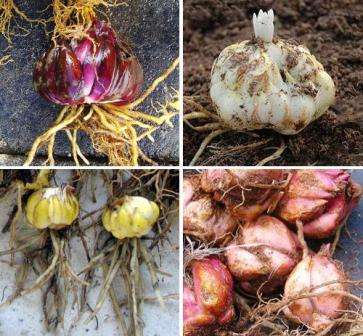

Algorithm for forcing bulbous flowers at home:
1. Prepare large, healthy bulbs for distillation. In the flower shop you will be offered material specially prepared for this. 2. Treat the planting material with a potassium permanganate solution or a suitable fungicide. If the purchased bulbs have passed this step before they go on sale, you can skip this step. 3. Plant in wide and low containers with a drainage layer at the bottom and holes for water outflow. Soil: turf + humus + sand. Large bulbs are not sprinkled completely, small ones are sprinkled on top with a layer of 1-3 cm. After watering, the containers are covered with an opaque material that allows air to pass through.
Forcing bulb flowers begins with autumn planting
4. Place the containers with the planted bulbs in a cool place (+ 4-8 ° C) for 10-14 weeks. It is better not to allow the soil to completely dry out during this period. 5. Move the pots to a lighter and warmer place (10-15 ° C) when the planned wake-up time comes. 6. Bring the flowers into the living area and place them on the window when the buds begin to take on their characteristic color. It is better to put them in a cooler place at night.
The onset of autumn does not mean that there is no more work for you in the garden - the life of plants, although it ends its development this season, does not stop at all. In addition to caring for the flowers that still decorate the garden, it is time for gardeners to prepare the site for the next growing season and implement winter planting flowers
that will bloom next year.

